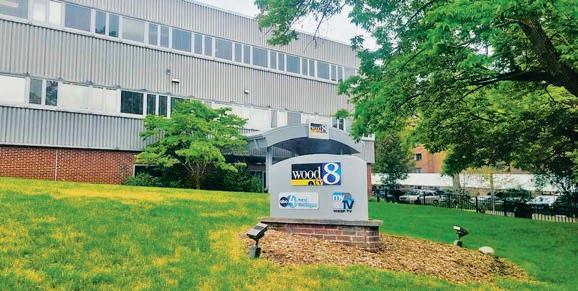

“AS SOON AS I MOVED IN, I WISH I’D DONE IT SOONER.” ADVERTISEMENT CRAINSGRANDRAPIDS.COM I JUNE 24, 2024 VOL. 41, NO. 13 l COPYRIGHT 2024 CRAIN COMMUNICATIONS INC. ALL RIGHTS RESERVED
The best thing about life here is that it’s always getting better.








Optimism isn’t just the expectation that life will get better. It’s the determination to make it so. For the staff, residents and management of Beacon Hill at Eastgate, that spirit is the engine that drives us forward.
We’re proud of having built a senior living community that has been recognized here in Grand Rapids and around the nation for our operational excellence and our culture of compassionate care.








Proud, but not yet satisfied. Because every day, we identify new ways and implement new ideas to improve the health and happiness of our residents and strengthen our connection to the city around us. So that everything we do now, we will soon do even better.
After all, why accept what is when you can create what could be?
“I’m eating better, exercising better and sleeping better than I have in years.”


Find out more of what’s in store for the future here at Beacon Hill. 616-378-8944 | BeaconHillGR.org | sales@beaconhillgr.org
A pessimist is just an optimist who doesn’t live here yet.







What are you looking forward to? It’s not a question we always remember to ask ourselves, but it’s a pretty clear indication of how happy we are.
People here at Beacon Hill can’t wait for tonight. Or tomorrow. Not necessarily because they have big plans—though they often do. But because they have high expectations.
They know they’ll talk to someone interesting about something interesting. Enjoy an invigorating walk or workout. Be informed, entertained and well-fed. Smile at familiar faces. Sleep well and securely in their own bed. And wake up excited to see what’s next.














“I don’t always know what tomorrow will bring. But I know I’m looking forward to it.”
Learn more about how life is getting better at Beacon Hill. 616-378-8944 | BeaconHillGR.org sales@beaconhillgr.org


OWNER DEFAULTS ON DOWNTOWN OFFICE TOWER
Corewell Health’s departure from Bridgewater played key role
By Kate Carlson
e owner of the skyline-dening Bridgewater Place o ce tower in downtown Grand Rapids has defaulted on a $37.3 million loan after its lender grew concerned when the building’s largest tenant left.
Real estate information service CoStar reports that the California-based Hertz Investment Group failed to pay a cash deposit totaling $1.52 million to its lender, landing the company in default on its loan for the prop-
erty. Hertz’s lender demanded the payment after Corewell Health moved out of the facility as the health system consolidated into its own o ce campus nearby. Corewell declined to renew its lease at Bridgewater Place in February 2023.
Hertz received notice from its senior lender in April this year of a “cash sweep event retroactive to early 2023,” and demanded Hertz deposit $1.2 million into a lender-controlled account, according to an a liate’s ling on May 23 with the Tel Aviv Stock
Exchange.
e company said it now expects contractor liens on the property after the lender stated it would not release certain tenant improvement funds after failing to receive the $1.2 million payment.
“It is vital to have reserve funds released to the property, as in addition to removing liens that would create breaches to our loan, the property needs to release its current vacancies to
See BRIDGEWATER on Page 22
Revived development plans could reshape East Grand Rapids
The 8.6-acre site would include residential units, parking garage and commercial space
By Rachel Watson
Developers are reviving plans rst proposed 20 years ago for a massive mixed-use development that now calls for 180 units of housing and commercial space at a long-vacant site in East Grand Rapids. Scott Wierda and Brian DeVries, co-founders of Jade Pig Ventures, now doing business as Gaslight Investors LLC, went before the East Grand Rapids Planning Commission on June 11 with
a new plan to redevelop an approximately 8.6-acre, mostly vacant site that they own between Wealthy Street and Lakeside Drive SE in East Grand Rapids. e developers’ new plan for the parcels at 515 Lakeside Drive SE and 2255 Wealthy St. SE, which are adjacent to Jade Pig’s headquarters, calls for seven new buildings that would include 180 units of apartments and townhomes, 56,970 square

FORUM: K-12 STANDARDS
Michigan schools rank near the bottom. A x will take more than just money. PAGE 9

How a prominent boat dealer landed in bankruptcy
It’s been a whirlwind few months for Tommy’s Boats
By Crain’s Grand Rapids Business Staff
For the past two months, a major nationwide boat dealer based in downtown Grand Rapids has been embroiled in three separate lawsuits between a supplier and two banks, with fraud accusations and hundreds of millions of dollars at stake.
On May 20, the nancial maelstrom engul ng Tommy’s Boats LLC reached a new phase when


the company led for bankruptcy protection to hopefully nd a buyer and pay back creditors at “the highest possible value.”
Company president and owner Matthew Borisch on June 4 offered his version of the events in a 21-page declaration. He blames Tommy’s Boats’ primary supplier for leaving the company with no choice but to le for bankruptcy, having intentionally “bled (Tommy’s) dry” through an elaborate inventory oversupply scheme.
Meanwhile, Tommy’s Boats’ two largest creditors have targeted the company in separate lawsuits. Here’s a breakdown of how the company got here and what’s at stake:
What
is Tommy’s Boats?
Founded in 1981 in Denver, Colo., Tommy’s Boats was later

CRAINSGRANDRAPIDS.COM I JUNE 24, 2024 VOL. 41, NO. 13 l COPYRIGHT 2024 CRAIN COMMUNICATIONS INC. l ALL RIGHTS RESERVED
Developers
a massive mixed-use development
East
| COURTESY OF GASLIGHT INVESTORS
are reviving 20-year-old plans for
that would reshape downtown
Grand Rapids.
Tommy’s Boats has a showroom at 247 Morrissey Drive NE in Comstock Park, between West River Drive and U.S. 131. | JOE BOOMGAARD
California-based Hertz Investment Group has owned Bridgewater Place for more than a decade. ANDY BALASKOVITZ
See EGR on Page 22
See TOMMY’S on Page 21
Tomorrow is more memories in the making.
Tomorrow is on.SM
Nothing brings people together like a BBQ. That’s why Enbridge is reducing greenhouse gas emissions by blending renewable natural gas and hydrogen into our network. It’s one of the ways we’re fueling family time today, and for years to come.
Learn more at tomorrowison.com

















Doctors create new kind of emergency clinic
RightCare would provide services in the space between what urgent care and hospitals now offer
By Mark Sanchez
A physician group that staffs emergency rooms at hospitals including Corewell Health plans to open its own Grand Rapids clinic next month offering a new model for care that it hopes could expand to additional locations.
Emergency Care Specialists
P.C.’s RightCare Clinic will provide a level of care above what’s available at an urgent care center, yet below what hospitals provide in an emergency room for cases such
as trauma injuries, strokes and heart attacks.
RightCare Clinic will include services such as medical imaging — X-ray, CT, and diagnostic ultrasound — diagnostic labs and cardiac monitoring that urgent care centers lack and refer patients to a hospital to access.
“We know there are a lot of things in the ED that could be seen elsewhere if there was the right provider mix, the right available tests and treatment, and those sorts of things,” John Throop, pres-
ident of Emergency Care Specialists, told Crain’s Grand Rapids Business. “We’re intermediating ourselves between the urgent care and the ED, providing a higher level of service without having to do the strokes and the traumas and the heart attacks and those things.”
Emergency medicine physicians will staff the new RightCare Clinic when it is scheduled to open on July 8 in a former West


Grand Haven eyes options for Chinook Pier rebuild
City officials are confident one of the three choices will be selected to move forward
By Mark Sanchez
City leaders in Grand Haven are weighing a trio of proposals to redevelop a prime downtown location along the Grand River.
The city received three proposals this spring that each envision varying ideas to redevelop a 3.4-acre
area known as Chinook Pier located toward the end of Grand Haven’s popular mile-long riverfront walkway to Lake Michigan.
The proposals came from the Grand Haven-based Cherette Group LLC, Grand Rapids-based CopperRock Construction Inc., and a joint venture between Zee-

land-based Geerlings Development Co. and Midwest Construction Group.
Geerlings and Midwest submitted the only proposal more than two years ago when the city first sought ideas from developers to reuse the space.
Rather than proceed with the one proposal, the Grand Haven City Council opted instead to pause


Tax credit reviews hamper historic preservation projects
Wait times approaching six months play havoc with construction schedules
By Kate Carlson
The state’s historic preservation tax credit program is making it increasingly difficult for developers to stay on budget and meet timelines, as an influx of applications and limited staffing causes longer wait times during the approval process.
A six-month backlog has developed since lawmakers three years ago reinstated the historic preservation tax credit, which was created under former Gov. John Engler and phased out in 2011 under former Gov. Rick Snyder. The program provides tax credits of up to 25% of qualified costs to rehabilitate historic buildings and sites that are certified by the State Historic Preservation Office.
Meanwhile, state lawmakers have proposed significantly growing the program to expand the annual amount available in credits as well as the type of properties that qualify.
The recent delays were caused in part by an increase in applications and limited staff at Michigan’s State Historic Preservation Office, said Otie McKinley, spokesperson at the Michigan Economic Development Corp.
The spike in applications follows the reinstatement of the State Historic Tax Credit program that was signed into law Dec. 30, 2020, he said.
“With the historic tax credit resolution, there have been an incredible number of applications that have come into the SHPO office, which is fantastic,” McKinley said in an emailed statement. “With that influx, a backlog had built up. We are working to increase the staff on the team to ensure that we can reduce the time frame.”
The delay in reviewing projects is now setting back developers looking to preserve, rather than demolish, old buildings.
Pinnacle Construction Group Inc. first announced plans in 2022 to convert historic Grand Rapids buildings along the Grand River into a mixed-use development. Project plans at 974 Front Ave. NW have since changed to replace some of the proposed office space with more apartment units, calling for multiple amendments to site plans. Those changes added more time to the historic preservation tax credit application process with

June 24, 2024 | CRAIn’S GRAnD RAPIDS BuSIneSS | 3
Emergency Care Specialists P.C. is opening a new RightCare Clinic in a former West Michigan Cardiology facility on the East Beltline Avenue near Bradford Street in Grand Rapids. | COuRTeSY PHOTO
Pinnacle Construction Group plans to convert historic industrial buildings at 974 Front Ave. NW into housing and office space. KATe CARLSOn
(Right) Cherette Group submitted one of three redevelopment proposals for Grand Haven’s Chinook Pier. The company’s proposal includes plans for a children’s museum. | PROGReSSIVe COMPAnIeS See HISTORIC on Page 22
Rendering from CopperRock Construction’s proposal. | ARCHITeKTuRA
See RIGHTCARE on Page 23
|
Image
from
Geerlings Development and Midwest Construction’s proposal.
ARCHITeKTuRA
See CHINOOK on Page 23
(Above) The city of Grand Haven has been in the process of reimagining Chinook Pier after it was forced to demolish buildings that once housed several retail shops because of flood water damage. | MARK SAnCHeZ
Suburban midcentury escape featured on Magnolia Network
By Rachel Watson
A home in quiet suburban Grand Rapids is up for sale two years after it was featured on a nationally ranked designer’s TV show.
Dan and Sarah Matthews put their four-bedroom, two-bathroom ranch home in Plainfield Township on the market for $425,000 earlier this month, as they look for a spot in the city.
“We moved here from Los Angeles, so we were really interested in having a private, quiet escape,” Sarah Matthews said of the home.
Anna Alvarez, a Realtor with Five Star Real Estate in Grand Rapids, has the listing.
The couple’s kitchen renovation for the approximately 2,000-square-foot brick house built in 1967 was featured on episode three of “Inspired Interiors with Sarah Sherman Samuel” in 2022. The show aired on the Magnolia Network and now lives on the streaming service Max.
Sarah Matthews, a native of Michigan’s east side, is an artist who works with Samuel as managing director of Sarah Sherman Samuel Inc. The Ada Township-based design studio in December was listed on Architectural Digest’s 2024 AD100 list of the top design professionals in the nation.
Dan Matthews, who’s from Grand Rapids, is a global digital marketing manager at Dematic.
The couple’s home, which is in the Northview Public Schools district, sits on about one-third of an acre across the street from Dean Lake and a short walk from a small man-made pond. The house is also close to Provin Trails, Robinette’s and the Knapp’s Corner shopping center.
Sarah Matthews said while she and her husband have loved the calm, safe, family-oriented neighborhood since buying the home for $280,000 in 2021, they are now looking to raise their 2-year-old in a more urban neighborhood, like Eastown or East Hills in Grand Rapids.
“We realized after we had a daughter that we really would like to live somewhere a little bit more walkable and closer to coffee shops and the farmers market and all of that,” she said.
At the same time, Matthews said it will be hard to say goodbye to the house after all the work they put into it.
“Sitting in the living room in the morning, with the sliding doors open, and you hear the birds (while) having coffee, it’s just such a serene feeling,” she said. “I think I’ll miss that a lot when we move closer to the city.”
About the price
Alvarez said it’s unusual to find
a midcentury home in this condition, with a kitchen designed by an AD100 designer, so close to mid-tier pricing. The median home price in Plainfield Township was about $410,000 in April, according to Redfin.
To set the price, Alvarez looked at recent comparable home sales, including a place a few doors down that was listed for $399,000 and is expected to close at $456,000.
She said she felt comfortable with a higher starting price for the Matthews’ home, because the other place didn’t have a modernized kitchen.
“(The Matthews) are going to honestly have some good interest, just with how nice the kitchen and the living room and the (neighborhood) are,” Alvarez said. “And I know that there are a lot of fans of the designer who did (the kitchen).”
‘California canyon’ kitchen
Though they’re all Michigan natives, Samuel and the Matthews couple lived in Los Angeles for several years and fell in love with the earthy, neutral color palette common in California.
So when it came time to design the kitchen, they went with what they called a “relaxed California canyon” design theme.
“The color palette is muted, warm and comforting,” Samuel said in the Magnolia Network special about the renovation.
In addition to its dated tiles and cabinetry, the pre-renovation kitchen was inconvenient, with an L-shaped peninsula extending from the main counter that compressed the space and cut it off from the dining area. It could only fit one person at the time.
To open it up, they removed the peninsula, extended the kitchen counter down the exterior wall and added one streamlined floating island in the middle. In the corner, they added a built-in banquette dining area that flows into the kitchen. Matthews found a vintage stone table base in Northern Michigan for the eating nook, and Samuel’s father built a custom oval wood table top to fit over it.
On the interior wall, they extended the cabinetry all the way down the length of the room surrounding the fridge, with space for two long shelves in between to display Matthews’ pottery collection.
To build the cabinets, the Matthews couple combined IKEA cabinet boxes with Semihandmade brand custom door fronts that they painted themselves, then topped with oak veneer countertops.
They chose a changeable paint color for the cabinets that looks olive green in the morning but fades to a peanut butter brown in the evening light. They also painted




the banquette benches the same color to match.
Matthews said the kitchen renovation ended up being more extensive than they expected. They needed to remove soffits in the walls to reconfigure the kitchen, which then necessitated re-drywalling three of the walls and half of the ceiling.
The rest of the house
The couple did more work on the house after the TV show was filmed. They repainted it from top to bottom, transforming the previous hues of lavender, dark gray and yellow to a neutral, warm white.
The only exception to that was their daughter’s nursery walls, where they hung strawberry vine patterned wallpaper from the Danish brand Ferm Living.
They also laid new wood flooring in the kitchen, living room, hallway and stairs. In the living room, they kept the original midcentury brick fireplace that takes up an entire wall.
All the changes — which represented an investment of about $60,000 — made the “whole house feel modern and light and airy,” Matthews said.
The home has a wooded backyard with slider doors off the living room that open onto a deck. Matthews said she gets a “treehouse vibe” looking out her windows at all the greenery.
The lower level is a full daylight basement with a walkout sliding door off a second living room.
Both Alvarez and Matthews said the home’s layout, with a master bed and second bedroom on the main floor and two additional bedrooms and a den downstairs,
would be ideally suited to housing a two-generation family, with a parent-in-law or teenage children downstairs.
Or, it could potentially be split into two units of about 1,000 square feet each, they said. Two-family dwellings are permitted in the neighborhood’s existing zoning of R1-residential as long as the attached accessory unit is less than 1,200 feet, per the township’s zoning ordinance.
Whoever ends up buying the home will be privileged to enjoy “really supportive” neighbors with children of all ages, Matthews said.
“It just feels really safe and great for a family,” she said. “Having access to nature has been great, and then also just the floorplan being so livable and the basement being clean and dry, (the house is) just easy to live in.”
4 | CRAIN’S GRAND RAPIDS BUSINESS | JUNE 24, 2024
This home on a quiet street in Plainfield Township had its kitchen renovation featured on the Magnolia Network and is now listed for $425,000. NEXT DOOR PHOTOS










































As Michigan’s leading nonprofit senior living and care organization, Holland Home is here to help you make the most of your aging journey. From vibrant Independent Living to expert healthcare as you age, our full continuum of care ensures residents live life to their fullest. Here at Holland Home, you always have a place to make yours in a community that nurtures more possibilities and opportunities. For more information visit
or call (616) 643-2730.
hollandhome.org

Pain management medical practice files for bankruptcy
By Mark Sanchez
Michigan Pain Consultants P.C. has sought federal bankruptcy protection to continue paying employees and operating clinics in West Michigan until the company’s closure, which it anticipates to happen by August.
The Chapter 11 petition filed June 12 in U.S. Bankruptcy Court for the Western District of Michigan in Grand Rapids claims the pain management practice has $100,011 to $500,000 in assets and $1 million to $10 million in liabilities.
In the petition, the company listed a range of debts including a $350,000 loan from Fifth Third Bank and $700,000 owed to McK-
connection with maintaining operations, including paying employees, continuing production of current products, and providing service to its customers” as the business winds down operations.
“Failure to pay these and similar critical expenses would cause the (Michigan Pain Consultants) immediate and irreparable harm by disrupting its ability to maintain operations,” according to the court filing. “(Michigan Pain) does not have sufficient unencumbered funds to meet these expenses.”
Michigan Pain Consultants estimated that it will need nearly $4.5 million over three months as it winds down.
The practice operates pain management clinics in Grand Rapids, Wyoming, Muskegon, Holland, Greenville and Big Rapids.
“We are simply unable to sustain the rising costs or keep up with the changes rapidly happening in the healthcare market. Our team at MPC is committed to ensuring a smooth and safe transition for all our patients during this difficult time.”
Michigan Pain Consultants website
esson Corp., a Cincinnati, Ohiobased distributor of pharmaceuticals and medical supplies. Both Fifth Third and McKesson previously filed liens against Michigan Pain Consultants’ assets, including cash.
The bankruptcy filing included a motion that asks the court to allow Michigan Pain Consultants to use its cash to “pay expenses in
Earlier this month, the 40-year-old Michigan Pain Consultants announced that it plans to end operations over the next 90 days.
“We are simply unable to sustain the rising costs or keep up with the changes rapidly happening in the healthcare market. Our team at MPC is committed to ensuring a smooth and safe transition for all our patients during this difficult time,” according to a notice posted on the company’s website. “We will work closely with you and your health care providers to provide the best possible care and support as we close our doors. The transition process will involve a thorough evaluation of your current healthcare needs and making the necessary arrangements for you to receive continued care with your primary care physician or another pain program.”
In a declaration accompanying the bankruptcy petition, Michi-

Owners to raze Brann’s Steakhouse for new development
By Abby Poirier
Grand Rapids staple Johnny Brann’s Steakhouse & Grille is closed to clear the way for a “bold” new mixed-use development that will serve as a new gateway to the west side.
gan Pain Consultants Executive Director Stacy Ward wrote that the company filed the case “in an effort to effectively manage the wind down of its practice with a goal of maximizing recovery for the bankruptcy estate and ensuring patient care.”
Lacking bankruptcy protection as the business winds down this summer, Michigan Pain Consultants “would suffer irreparable harm, because it will be forced to immediately shut down,” Ward stated in the filing.
The declaration notes that prior to the bankruptcy filing, Michigan Pain Consultants “encountered financial difficulties with respect to its debtor/creditor relationships with parties,” including Fifth Third Bank and Medicare.
Michigan Pain Consultants owes the top 20 debtors listed in the bankruptcy petition a combined $5.1 million, according to the filing.
A number of local companies are listed as unsecured creditors, including:
w 2147 Health Drive LLC, Grand Rapids, $229,109
w 6896 Greenville LLC, Grand Rapids, $34,042
w Grand Rapids Township, $31,992
w Brockton Properties LLC, Grand Rapids, $297,963
w Helix Scribes, Grand Rapids, $102,100
w Holland Medical Office Equities, Grand Rapids, $98,268
w MPC Real Estate Holdings, Grand Rapids, $571,210
w Nexus Properties 1 LLC, Muskegon, $75,929
w Stratus Bldg Solutions of West Michigan, Wyoming, $40,699
w Varnum LLP, Grand Rapids, $31,595
The attorney representing Michigan Pain Consultants, Charles Bullock of Stevenson Bullock
P.L.C. in Southfield, was not immediately available for comment.
Plans for the site at 401 Leonard St. NW, at the northwest corner with Turner Avenue near U.S. 131, call for a new mixed-use housing development with up to 102 apartments, retail space and a new 4,000-square-foot restaurant.
“We’re excited to put something very big and bold and new there,” Johnny Brann Jr., who is co-leading the project with his father, Johnny Brann Sr., told Crain’s in an exclusive interview.
According to Brann Jr., the overall price tag for the development will be approximately $30 million. The new building will be between four and five stories tall, and preliminary designs include a mix of one- and two-bedroom units, a new 170-space parking lot, a gym and commercial spaces ranging from 1,300-1,500 square feet.
The owners have selected Rockford Construction as the construction manager for the project, while Hendrickson Architecture is leading the design.
The redevelopment could open in about two years, Brann Jr. said.
“We hope to begin development within the next six months, maybe up to 12. It just depends on the process,” Brann Jr. said.
“But we’re ready to go with the planning of it and we’re in a pretty good spot with (what) we think the best and highest use of the property will be.”
To facilitate the development, the owners plan to raze the approximately 9,000-square-foot Johnny Brann’s Steakhouse & Grille, which underwent a $1 million renovation in 2020 and reopened in 2021.
The restaurant closed June 14. All 20 employees will move to the local restaurant chain’s other locations.
Brann Sr. said in a statement that closure comes in part “to evolve with the trends and meet
our customers’ ever-changing tastes.”
“What lies ahead is an opportunity to not just preserve, but to continue building upon our family legacy, ensuring that the west side of Grand Rapids remains a place where our community can come together and create lasting memories,” Brann Sr. in a statement.
The move will result in the closure of a restaurant that’s been part of the west side for more than five decades, having opened in 1974, but the iconic sizzler steak will be back in due time.
The new ground-floor restaurant will “have an affiliation to Brann’s” although Brann Jr. said they are still fine-tuning the new concept. The plans call for keeping the signature sizzler steak on the menu to pay tribute to the Brann family legacy.
“We’re playing with some unique ideas with our chefs and consultants right now,” Brann Jr. said. “It’s been a great 50-year run (for the restaurant), and super successful. There’s a lot of momentum on Leonard Street right now, some great new businesses have gone in, some new developments are going in. A lot of really great momentum is happening. We’re just honored to be part of it. And (this site is) kind of an entry point, the gateway into the west side.”
Brann Jr. has been a part of the revitalization of the Leonard Street corridor. He previously invested in a new headquarters building at 415 Leonard St. NW for Interphase Interiors, a Haworth dealer he bought with Dave Shaffer in 2018.
The third-generation restaurateur also owns Kitchen 67 at 1977 East Beltline Ave. and the Woodrow’s Duckpin Bowling lounge in downtown Grand Rapids’ Amway Grand Hotel.
“My dad’s been there for so long, for 50 years, and it’s been such a great landmark to have there,” Brann Jr said. “But he’s also always had the vision to think what more could we do with this parcel if the right opportunity came along. And the right time came along.”
6 | CRAIN’S GRAND RAPIDS BUSINESS | JUNE 24, 2024
Brann’s Steakhouse and Grille at 401 Leonard St. NW is closed to make way for a new mixed-use redevelopment. | COURTESY FILE PHOTO
A Michigan Pain Consultants PC office near Muskegon. MARK SANCHEZ
State electric boating grant program in limbo
By Rachel Watson
The electric boating industry is calling on state officials for more full-fledged support to help it gain a foothold in the mobility sector, similar to the way Michigan has backed electric vehicles.
Last year, the state’s Fresh Coast Maritime Challenge committed about $500,000 to six organizations working on decarbonization, e-boating and e-charging initiatives. The program, considered an initial funding phase, was touted as part of Gov. Gretchen Whitmer’s larger mobility plan to meet the state’s goal to become carbon neutral by 2050.
However, 10 months after grants were awarded, the program’s future is uncertain as the Michigan Economic Development Corp.’s Office of Future Mobility and Electrification evaluates how the grant program fits with broader mobility goals.
Participants say they hope the state isn’t backing off too soon.
Dana Lowell, CEO and co-founder of Holland-based Lilypad Labs, said the state will need to play the long game to truly decarbonize the maritime mobility sector.
“It could take generations, probably. The technologies are not all mature, the charging infrastructure isn’t established yet, the manufacturing capacity and consumers’ awareness isn’t there yet, and all of that has to happen,” said Lowell, whose company received $135,000 under the grant program. “A good parallel is the electrification of automotive, and you can see the journey that’s been on. Boating isn’t going to be a whole lot different.”
Charlie Tyson, technology activation director for the Office of Future Mobility and Electrification, said the department is still discussing whether the Fresh Coast grant program will continue.
Meanwhile, Tyson said his team is focused on “helping the projects that have currently been awarded continue to see success” while working with other state agencies “to understand where there might be overlapping opportunities as it relates to maritime.”
“We do have a coordinated effort to identify ways that we can more impactfully support the clean maritime sector, both for recreational watercraft and commercial freight, and looking at more than just electrification, looking at hydrogen or carbon capture technologies or hybrid,” he said. “(We’re) making sure that we’re looking at carbon emission reduction beyond just electrification, though that’s important, as well.”
Tyson said there’s “more to come,” but he believes the state is “on the right track.”
How Fresh Coast started
The state’s Office of Future Mobility and Electrification partnered with the Grand Traverse region’s chamber of commerce, Traverse Connect, to create and administer the Fresh Coast Maritime Challenge, which focused on Northwest Michigan.
Traverse Connect President and CEO Warren Call said the state’s mobility plan surfaced as a group of players in the Grand Traverse area began forming in 2022 to make northwestern Michigan a hub for freshwater research, innovation and commercialization.

Traverse Connect, along with Northwestern Michigan College, the Discovery Center & Pier, 20Fathoms and Michigan Technological University are working on a plan to create a Freshwater Research & Innovation Center that would, among other things, help scale startups working on technologies to protect the Great Lakes ecosystem.
While the center isn’t built yet, the group last year started researching e-boat technology and got connected to London-based manufacturer Aqua SuperPower, which makes rapid marine chargers, as well as a few companies that make e-boats. Soon, they began working to make the Grand Traverse area North America’s first e-boat charging corridor, starting with installing one Aqua SuperPower rapid charger at a marina in Elk Rapids and another in Northport.
To get more funding, Call said, “We then went and pitched it to the Office of Future Mobility at the MEDC and ended up partnering with them and got the governor’s approval to get this grant program
going,” he said, referring to the Fresh Coast challenge.
Targeting the popular boating corridor between Frankfort and Mackinac Island, the Fresh Coast challenge was created to spur adoption of new technologies and investment in Michigan by early-stage startups working on clean-fueled boating technology, Tyson said.
Applications opened in April 2023, and the following six companies received a total of $506,000 last August:
Torrance, Calif.-based recreational e-boat maker Arc Boats received $20,000 to conduct demos.
London-based Aqua SuperPower received $111,000 to install more fast marine chargers in Northwest Michigan.
Farmington Hills-based e-boat powertrain producer Hercules Electric Mobility received $75,000 to develop and deploy e-boats.
Lilypad Labs deployed rentable solar boats at public marinas.
Michigan Technological University in Houghton received
$50,000 for studying and developing a playbook for bolstering charging infrastructure.
Beaverton, Ore.-based Voltaic Marine Inc. received $115,000 to develop e-boat manufacturing in Michigan.
Call said while the “e-charging corridor” isn’t fully built out yet, Aqua SuperPower, which also supplies charging stations for electric yachts, is in the process of using grant funds to install more around Grand Traverse Bay.
Wish list for the future
Lowell, of Lilypad Labs, said that while the Fresh Coast challenge was “a good start,” the state needs to do more to invest in its “blue economy,” just as it has to compete in the EV race in automotive.
He said the Fresh Coast challenge “should be happening every year,” with dollar amounts that increase annually, “to really stimulate the economy around the Great Lakes, which is an asset we have that no one else does.”
Lowell said the program benefited Lilypad Labs, which was able to use its grant dollars to sell its solar-powered boats to public marinas in Elk Rapids, Traverse City, South Haven and Saugatuck that will then rent them out to groups and individuals. He is hopeful that visibility will then lead to more funding opportunities so he can scale the startup.
“The objective is at the end of the summer, it’s going to be to scale or die,” he said. “We’re either going to scale it, or we’re going to have to do something different with it. The plan is to raise money and scale it.”
Soccer stadium operator taps nonprofit to book venue
By Kate Carlson
The future operator of a proposed downtown Grand Rapids soccer stadium wants to work with the West Michigan Sports Commission to schedule programming at the stadium when it’s not being used by a professional team.
The Grand Rapids-Kent County Convention/Arena Authority Board of Directors voted June 7 to authorize ASM Global to work with the WMSC to develop a booking policy for the $175 million, 8,500-seat soccer stadium.
The stadium developer, Grand Action 2.0, has said 17 professional soccer matches could be hosted at the stadium annually. An additional 56 community events could also be held at the venue just west of U.S. 131, drawing a combined total of 164,000 visitors per season.
WMSC President Mike Guswiler said setting dates for the professional soccer matches would be the main priority for the venue.
Beyond that, the WMSC would work with the CAA and ASM Global to fill the venue on non-competition dates with sporting events
that could include rugby, football and lacrosse, as well as other events that would benefit from the stadium’s wide open space, Guswiler said.
“We’ve already begun to identify some opportunities and we feel like we could bring in maybe two dozen events that could fill hotels and restaurants,” Guswiler told Crain’s. “For an investment of this nature, what we’re looking at is how we can maximize its value and its return to the community.”
Some organizations, including the Great Lakes Intercollegiate Athletic Conference, have already reached out to the WMSC to inquire about hosting sporting events at the arena, Guswiler said. Schools in the GLIAC include Grand Valley State University and Ferris State University.
During community feedback sessions that Grand Action 2.0 held for the soccer stadium project, many residents were interested in seeing local youth soccer and other sports teams having an opportunity to play at the soccer stadium.
Rich MacKeigan, regional gen-

eral manager for ASM Global, said while the soccer stadium wouldn’t be a community park, opportunities for local teams to use the facility could be made available.
“It’s a joint effort, and this entity, the CAA, needs to set the priority for the use of the facility,” MacKeigan said during the meeting. “There is absolutely a place for local utilization, absolutely, but it is not a community park open to everybody and that is the distinction.”
The WMSC is a nonprofit that formed in 2007 and hosts youth
and amateur sporting events. In 2023, the WMSC hosted 121 events for a total of 277,980 athletes, which resulted in 43,775 hotel night stays and nearly $88 million of estimated economic spinoff, according to the nonprofit’s latest annual report. The Meijer Sports Complex and the Meijer State Games of Michigan are two additional operating branches of the WMSC. Helping to book events for the soccer stadium would lean into work that the WMSC already does,
Guswiler said.
“As an operation, we’ve grown in our over 16 years to three core operations, and our primary mission is to be an economic generator through sports tourism,” Guswiler said.
The WMSC has a department in services and sales that reaches out and identifies events that are open for bid. They specialize in youth and adult amateur sports and bring in statewide, regional and national competitions to the area, Guswiler added.
“Bringing in another professional team will only highlight that we’re a great sports destination,” Guswiler said. “This will bring so much more attention to our community and to our sports landscape and who we are as a destination.”
Grand Action 2.0 is simultaneously developing the Acrisure Amphitheater in downtown Grand Rapids, which broke ground on May 21. Live Nation is expected to serve as the venue’s principal booker after the CAA approved a term sheet with Live Nation on May 3, as Crain’s previously reported.
June 24, 2024 | CRAIn’S GRAnD RAPIDS BuSIneSS | 7
A rendering of Grand Action 2.0’s soccer stadium, looking northwest from the intersection of Pearl and Mount Vernon. | PROGReSSIVe COMPAnIeS
An “E-Marine Demo Day” last year at Elk Rapids Marina included test rides of the electric Vita Seal and X Shore’s Eelex 8000, both shown here. | COuRTeSY OF AQuA SuPeRPOWeR









BREAKING NEWS AS IT HAPPENS. CrainsGrandRapids.com/Newsletter Sign up for Breaking News Alerts and be the first to know when big stories break.

Michigan schools rank near the bottom.
A fix will take more than just money.
By Julie Mack
On a recent Monday at Childs Elementary in Ypsilanti, second grade teacher Lori Richert led her students through a discussion of wants vs. needs, referencing Abraham Maslow’s famous theory.
“Need is something you need to survive,” Richert explained, showing a chart illustrating Maslow’s hierarchy of human needs. “A want is something you don’t have to have.”
Ostensibly, this was a literacy lesson, one to help Richert’s second graders write an “evidencebased” research paper about a specific job and its role in a community. So is a teacher serving a want or a need? A doctor? A homebuilder?
What ensued was a lively discus-
sion among the two dozen 7- and 8-year-olds, a reading lesson far more sophisticated than the days of “Fun With Dick and Jane” books.
“We’re pushing students much harder than ever,” said Richert, a 2023-24 Michigan Regional Teacher of the Year and 23-year veteran instructor for the Lincoln Consolidated School District in southeast Washtenaw County.
Many would agree academic expectations have increased for Michigan’s K-12 schools. But in many communities, results are falling short.
Indeed, Michigan’s education system currently ranks 42nd in the United States and last in the Midwest, according to Kids Count, an annual analysis by the Annie E. Casey Foundation. The ranking was based on four indicators: per-
centage of 3- and 4-year-olds in preschool; fourth grade reading and eighth grade math scores on the National Assessment of Educational Progress tests; and ontime high school graduation rates.
“We are in really bad shape,” said Venessa Keesler, a former state deputy superintendent and CEO of Launch Michigan, a bipartisan nonprofit spearheaded by the business community a year ago to advocate for systemic education reform.
And it’s not just high-poverty schools that are struggling, Keesler said. In fact, a Launch Michigan data analysis shows a significant majority of Michigan districts are underperforming, including many in affluent communities.
See K-12 on Page 10
SPONSOR
Kids Count education ranking
Michigan’s education system currently ranks 42nd in the u.S. and last in the Midwest. The education ranking was based on four indicators: percentage of 3- and 4-year-olds in preschool; fourth grade reading and eighth grade math scores on the national Assessment of educational Progress tests; and on-time high school graduation rates. The darker the color equals a worse ranking.

June 24, 2024 | CRAIn’S GRAnD RAPIDS BuSIneSS | 9
No. 42 K-12 STANDARDS
Michigan:
Second graders take time for reading during a May school day at Childs Elementary in Ypsilanti. “We’re pushing students much harder than ever,” says their teacher, Lori Richert, a 2023-24 Michigan Regional Teacher of the Year, who works in the Lincoln Consolidated School District in southeast Washtenaw County. | Qu nn BAnKS
new Mexico: No. 50 Massachusetts No. 1
Sources: The Annie e. Casey Foundation
K-12 STANDARDS
Launch Michigan is among those urging a complete overhaul of the state’s education system, rethinking everything from school funding to the state’s oversight of K-12 districts, to improving the work environment for teachers to curriculum changes.
Some of that work already is underway, according to state Superintendent Michael Rice. He points to the state’s eight-point strategic education plan updated inå 2020, and says progress has been made on multiple fronts, particularly in the past two years.
That includes significant increases in the state’s K-12 funding, money that is being used for new programs to address Michigan’s teacher shortage, bolster early literacy instruction, provide more resources for special education and low-income students, and expand state-funded preschool for 4-yearolds, among other initiatives.
Launch Michigan officials agree that Michigan is beginning to move in the right direction, but believe the reforms need to go beyond the state’s strategic plan. They propose a framework with three basic components: Set high standards for a high school diploma; ensure districts have the resources to meet those standards, and create a governance model and accountability measures to ensure those standards are met, said Jeff Donofrio, CEO of Business Leaders for Michigan and chair of Launch Michigan.
“When you look at the states that have undergone these transformations, it’s a decades-long process,” Donofrio said. “It’s not just putting a little more money into the system or some sort of silver-bullet answer. It’s going to have to be a holistic approach.”
How did we get here?
Thirty years ago, Michigan was among the top 10 states in perstudent funding and its NAEP reading and math scores were above the national average.
Even with the dip since the pandemic, Michigan’s academic indicators have actually improved since then. But Michigan’s rankings have fallen as many other states have experienced much bigger gains.
That’s because those other states have been much more aggressive about systemic education reform and are now seeing the results, said Karen McPhee, a senior education policy adviser in the Snyder administration and former superintendent of the Ottawa Area Intermediate School District. Now an education consultant, McPhee is on the Launch Michigan board. Experts point to several reasons why Michigan has lagged in overhauling its education system.
One factor: The demise of highwage, low-skill jobs occurred later in Michigan compared with other states, delaying the impetus for education reform.
Another reason: Once it became



apparent that Michigan was becoming less prosperous, state policymakers prioritized tax cuts to boost the economy, and education funding took a hit for many years.
A third issue: Michigan’s K-12 system is one of the most decentralized in the nation. The state has more than 800 school districts — the sixth most among the 50 states — and those individual districts have considerable autonomy.
Michigan also is one of the few states where the governor does not appoint the state superintendent nor oversee the Department of Education. That’s the responsibility of an elected state school board, which hires the state superintendent.
“The governance system here is disjointed,” Donofrio said. “You have multiple entities that have a piece of governance, whether it’s policy or funding or implementation, but no one who you can really say is accountable.”
Launch Michigan would like to give the governor the ability to appoint the state school board chair and hire the state superintendent with the “advice and consent” of the state school board.
Meanwhile, the Michigan Department of Education has appointed Brian Jacob, a University of Michigan expert on education policy, to lead a study on potential reform of the state’s education governance system.

10 | CRAIN’S GRAND RAPIDS BUSINESS | JUNE 24, 2024
K-12 From Page 9
Lori Richert and her second-grade Childs Elementary students focus on a literacy lesson in May. Educators say Michigan needs to be more aggressive about reforms to educate the state’s students more effectively. | QUINN BANKS
Average revenue and expenditures per student in Michigan Education in Michigan has seen increases in funding, including for efforts to bolster literacy instruction. But, state leaders say, more needs to be done to focus on effective programs to teach reading. | QUINN BANKS Source: Michigan Department of Education ’11-’12 ’12-’13 ’13-’14 ’14-’15 ’15-’16 ’16-’17 ’17-’18 ’18-’19 ’19-’20 ’20-’21 ’21-’22 ’22-’23 $12,000 9,000 6,000 3,000 0 $15,034 $14,475
Venessa Keesler Brian Jacob
“Michigan has structural issues,” Jacob said. “It is really incredibly decentralized, and the state superintendent has less authority than in other states.”
As an example of how that impacts student achievement, Jacob said, “we need a more coherent, science-based approach to early reading instruction. This is something more states are doing and it’s proving effective.”
So instead of letting each district choose its own early literacy curriculum, Michigan could mandate that districts choose from a limited number of curricula that have proven results.
Rice is supportive. “If you did nothing but constrained early literacy curricula to a few curricula with high value, high impact that can drive higher student achievement, that would be a big deal,” he said.
It would be especially effective if the districts were mandated or incentivized to pair those curricula with high-quality professional development, Rice added.
He noted the Michigan Department of Education is now sponsoring free online classes in LETRS, a highly regarded literacy training program considered especially effective in helping teachers work with students who have dyslexia or other learning disabilities.
About 7,000 educators have gone through the program so far, Rice said. “We’d like more money. We’d like more teachers in this. We’d like to quadruple the number of early elementary teachers in LETRS training.”
Setting higher standards
Officials at Launch Michigan applaud the LETRS program, but would like to go further and set statewide benchmarks for outcomes, particularly defining the skill set needed to earn a high school diploma.
The current Michigan Merit curriculum is about “exposure” vs. actual mastery of material, they say.
“How a kid gets to graduate is determined at the local level,” McPhee said. “That’s what we’ve accepted for 100-plus years of education in this state and we’re still accepting it today. There needs to be a state determination of what a kid should minimally be able to do in math and language arts and sciences and social studies in order to receive a diploma.”
Making that concept a reality requires helping students stay on track throughout their school career and providing swift and effective interventions when they begin to derail.
The key is “early and sustained interventions from day one” for atrisk students, McPhee said. “What we don’t want is to see a child get so far behind that it looks like the only remedy is special education. If that’s the appropriate remedy, then absolutely. But if it’s because we haven’t been able to support the teacher, provide those early interventions,” that’s not acceptable. High-quality preschool is one program that has shown results. Gov. Gretchen Whitmer called for
Percentage of proficiency on National Assessment of Educational Progress tests, 2022
Michigan is tied with four other u.S. states as having the 8th-lowest proficiency scores in reading and is the 14th-lo west state for math.
PROFICIENT IN 4TH GRADE MATH
Top 5
Wyoming 44%
Massachusetts (tie) 43%
nebraska (tie) 43%
Wisconsin (tie) 43%
utah 42%
Bottom 15
Arizona (tie) 32%
Maine (tie) 32%
Mar yland (tie) 32%
Michigan (tie) 32%
Mississippi (tie) 32%
California 30%
Alaska (tie) 28%
Arkansas (tie) 28%
nevada (tie) 28%
new York (tie) 28%
Alabama (tie) 27%
Lousiana (tie) 27%
Oklahoma (tie) 27%
Delaware 26% Washington, D.C. 24%
Virginia 23%
Mexico 19%
59,508
The number of teachers in Michigan for the 2022-23 school year. This is a 3.8% decrease from the average of 61,841 in the 2011-12 school year.
Average
PROFICIENT IN 4TH GRADE READING Top 5 Massachusetts 43%
(tie) 38%
Bottom 15
Arkansas (tie) 30% Missouri (tie) 30%
increase achievement in schools, your best bet is high-quality tutoring,” he said.
Another intervention is expanding the school day through after-school programs. Rice says the state has started funding such programs for the first time. “That’s a big deal,” he said.
Importance of teachers
Supporting teachers is a critical part of the puzzle, experts say. But many teachers say the system is failing in that regard.
Richert has been a teacher for more than two decades and the job has gotten harder over time, she says.
“I’ve seen this job change so much,” Richert said. “They keep adding more and more to our plate, but nothing is ever taken off.”
(tie) 28% Louisiana (tie) 28% Michigan (tie) 28%
$67,012
The average teacher salary in Michigan for the 2022-23 school year. This is a 7% increase from the average of $62,613 in the 2011-12 school year.
school teacher salary, 2022-23
Fifteen states and Washington, D.C., pay teachers more than Michigan. California, new York and Massachusetts pay the most, while South Dakota, Florida and West Virginia pay the least. The darker the color, the lower the average salary.
Richert works in a middle-class school district, “but even in my district, there’s a high turnover of younger teachers,” she said. “I think some of that is the needs of our students has increased so much, whether it’s social, emotional or academic needs. Thank goodness I have the experience to know how to approach those problems. But if I were a new teacher, I would kind of say, ‘I don’t know if I’m cut out for this. This is a lot to take on.’”
Even as the job has gotten harder, teacher salaries have been stagnated and benefits have been slashed. In the 1990s, Michigan teachers were among the highest paid in the nation. In 2021-22, the average starting pay for a Michigan teacher was $40,302, which ranked 41st in the nation.
In recent years, Michigan has experienced a teacher shortage, which has a direct impact on student achievement. Staffing a school with highly skilled teachers is considerably harder when experienced teachers are leaving the profession and there are limited candidates to fill openings.
The teacher shortage is particularly problematic for high-poverty districts where the job is more challenging and the pay is typically lower than affluent districts. That means children most in need of skilled, experienced teachers are less likely to have them.
If Michigan wants to improve academic achievement, teacher recruitment and retention is a key issue, experts agree. That means addressing the No. 1 reason teachers leave the profession: Burnout.
“We’re just not very good at making sure our teachers are supported and have access to professional growth,” McPhee said. “And teachers are hungry for it, especially young teachers. They want to do a good job. They want to be successful.”
continual mentoring, continual coaching, continual feedback. That investment makes all the difference in the world.”
“The state has made some really big and important steps to shore up our teacher pipeline,” Keesler said. “What we really haven’t done is agreed on where we’re going with all this reform.”
Need for more resources
Funding reform is another critical element.
Expert after expert makes a similar point: It’s no coincidence, they say, that Michigan’s academic outcomes stagnated at the same time that funding stagnated for K-12 schools.
In 2000-01, Michigan spent an average of $9,031 per K-12 student, 12% above the national average. By 2022-23, the Michigan average was $14,289, 15% below the national average. Indeed, between 2002 and 2015, Michigan ranked last in revenue growth for K-12 education, according to a study by Michigan State University.
Officials at Launch Michigan spell it out on their website: “For decades, Michigan has underfunded its schools, and now we are reaping the results of that disinvestment.”
However, in the past two years, Whitmer and the Democraticcontrolled Legislature have made education funding a priority. The state’s education budget has increased from $17.1 billion in fiscal 2022 to $21.5 billion in fiscal 2024, a 26% increase.
“The fiscal ’23 and fiscal ’24 budgets have been phenomenal,” Rice said.
Ensuring adequate school funding over the long term is one of the priorities of Launch Michigan. It’s especially important that districts with large concentrations of atrisk students get the resources they need, Donofrio said.
“Equity funding is so important. It’s something that’s been a priority for us for a very long time,” he said about Business Leaders for Michigan. “You need a (funding) multiplier for poverty. You need a multiplier for students who learn at a different pace or have special needs or have English as a second language.”
At the same time, Donofrio said, the state needs to ensure that money is being spent wisely and that districts are making forward progress.
Sources: The nation’s Report Card, Michigan Department of education and neA Ranking of the States, 2024
access to universal free preschool for 4-year-olds in her fiscal 2025 budget, but lawmakers have balked. Still, a further expansion of preschool in Michigan is set for this fall with state startup grants.
Another effective intervention is high-quality tutoring for struggling students, either one-on-one
or in small groups and led by either a teacher or someone with specific training, said Brad Hershbein, senior economist for the Upjohn Institute for Employment Research in Kalamazoo.
“Most of the research coming out of the pandemic says that if you want to invest in one thing to
But as an example, McPhee said, “what happens right now with professional development is teachers spend a day at a PD workshop. They go back to their classroom with little support about how to deploy those new skills, so they go back to what they know.
That’s not what happens in leading states and nations. They get
Systemic reform “is going to be a slow process at times,” he said. “The policy setting, the implementation, the funding — all of those things have to align under a very clear and accountable leadership structure to make the changes that will be necessary over a 10-year time period.
“So it’s not just a little more money here or a few more rules or a few more teachers in the pipeline,” Donofrio said. “It’s all going to be moving together and people will have to trust in that process. The most important thing we have to do today is create the ecosystem that will allow this multi-decade change.”
June 24, 2024 | CRAIn’S GRAnD RAPIDS BuSIneSS | 11 K-12 STANDARDS
public
West Virginia $52,870 Florida $53,098 South Dakota $53,153 new York $92,696 California $95,160 Massachusetts $92,307 Michigan $67,011
West
new
Florida
39% Wyoming (tie) 38% new Jersey (tie) 38% Colorado
nevada
Washington,
Delaware 25% Alaska
Oklahoma
24% West Virginia 22% new Mexico
new York (tie) 30% Tennesee (tie) 30% Texas (tie) 30% Maine 29% Alabama
Oregon (tie) 28%
27%
D.C. 26%
(tie) 24%
(tie)
21%
8 ways Michigan could improve student achievement
By Julie Mack
Michigan students are struggling. Michigan teachers are burning out.
The state is lagging national averages on a variety of academic indicators.
No surprise, calls are growing for systemic education reform.
State Superintendent Michael Rice points to an eight-point strategic plan as a map for a way forward. Meanwhile, a coalition of business leaders, educators and other stakeholders has created Launch Michigan, a nonprofit seeking a complete overhaul of the state’s education system.
Launch Michigan is promoting three concepts: Specify the skills needed to earn a Michigan high school diploma; ensure schools have the resources to meet those standards, and create a better system of oversight and accountability.
There are specific proposals to improve Michigan’s academic outcomes:
Rethink the structure
Michigan has one of the nation’s most decentralized K-12 systems.
The state’s 800-plus school districts have considerable autonomy. And in Michigan, the governor does not oversee the state Department of Education nor appoint the state superintendent; those are the responsibility of an elected state board of education.
“That disjointed nature at the top is really tough,” said Jeff Donofrio, CEO of Business Leaders for Michigan and board chair of Launch Michigan. Structural reform “is not the only answer, but it helps lay the groundwork and create an ecosystem that would allow change.”
The Michigan Department of Education recently appointed an expert in education policy to lead a study on how to reform the state’s education governance system.
Rethink K-12 funding
Michigan needs to spend more money on education, particularly in providing more resources to high-poverty districts with large numbers of struggling students, many say.
As for where to find that money, Donofrio noted that Michigan’s student population is shrinking, which means more money per student.
He also pointed out that the state currently spends about $2.5 billion a year to cover unfunded liabilities in the state pension plan for school employees; those subsidies are scheduled to end in 2038, which potentially frees up that money. Donofrio also suggested there are more economic efficiencies to be had in relying on intermediate school districts to handle business services such as payroll for local districts.
Michigan already is reallocating its budget to spend more on schools. In the past two years, the state has increased its education budget by 26% to fund a variety of new initiatives.
Address state’s teacher shortage
Experts agree a vital factor in improving outcomes is ensuring the state has an adequate pool of skilled teachers. But Michigan has experienced a teacher shortage in recent years, as retirements have accelerated since the pandemic and fewer people are entering the profession as wages

have stagnated. In the past two years, the state has allocated almost $1 billion to bolster the teacher pipeline, Rice said. That includes money for scholarships to train more teachers, stipends for student teachers, a new student loan repayment program and paying veteran teachers to serve as mentors.
Other proposed reforms: Increase the incentives to attract and keep experienced teachers in high-poverty schools, and strategize on how to decrease burnout, the No. 1 reason teachers leave the profession.
The latter could include supporting teachers’ professional growth through more intensive mentoring, coaching and feedback — an investment that could help both teachers and their students.
Raise academic standards
Launch Michigan proposes establishing specific benchmarks that Michigan students must meet to earn a high school diploma.
“Frankly, if most high school graduates could read at a reasonable level — read newspapers, read books; if they could do math at a reasonable level where they weren’t intimidated by it; if they could write a work memo, then we would really have accomplished a lot,” said Tim Bartik, a senior economist at the Upjohn Institute for Employment Research.
But setting those high standards requires improvements throughout the K-12 system to ensure struggling students stay on track, experts agree.
Improve early literacy instruction
Many Michigan districts are still using a less-effective, outdated curriculum, and the state currently lacks the authority to mandate a change.
Michigan could require districts to use a high-quality early literacy curriculum. Rice, the state superintendent, says it would be even better if it was paired with high-quality professional development.
Just those two reforms alone “would be a big deal,” Rice said.
Create access to universal free preschool
High-quality preschool has long-term benefits for students and is an investment that eventually pays for itself, Bartik said.
In her fiscal 2025 budget, Gov. Gretchen Whitmer proposed access to universal publicly funded preschool for all Michigan 4-year-olds starting this fall. The Legislature has balked at that timing, but Michigan has significantly increased its state-funded preschool program in the past few years and continues to move toward universal access to free pre-K classes.
Expand access to high-quality tutoring
In terms of interventions for struggling students, the best bang for the buck is high-quality tutoring, said Brad Hershbein, a senior economist at the Upjohn Institute for Employment Research.
The tutoring can be one-on-one or involve small groups, he said, but it’s proven a much more effective intervention than retaining children in a grade. It’s also more effective and cost-efficient than cutting class sizes, Hershbein and Bartik say.
Improve accountability systems
Setting high standards and increasing school resources isn’t enough, Launch Michigan says. There also needs to be a
better system of accountability, to ensure that dollars are being spent wisely and standards are being met.
Giving the state more oversight powers would be useful, said Brian Jacob, a University of Michigan expert in education policy, but “I don’t think we want a system where there are automatic sanctions” and punitive measures against struggling schools.
A better strategy, he said, would be for the state “to identify which districts are not doing well for which students” and then use site visits to diagnose the issues and work with local officials to address them.
Venessa Keesler, the CEO of Launch Michigan and a former deputy state superintendent, is supportive of expanding a state initiative that partners an underperforming district with peers who have been successful.
“It’s about coming in and working alongside them and looking at things like curriculum,” she said.
The state also can use funding as a way to encourage districts to adopt best practices, she said.
“It’s like, OK, you can continue to choose your own curriculum,” Keesler said. “Or if you want this extra foundation allowance, you have to adopt one of the seven curriculums on the list."
It’s important to realize “Michigan can’t just fix our lowest performing districts if we’re going to get back on track,” she said. “We also have to nudge the happy middle, the districts that never show up on the low-performing lists.
“Every teacher I know is working really hard,” Keesler said. “Leaders are working hard. But we can’t keep expecting individuals to fix systemic problems. We have to get our system in order. Along with that is a communication element of getting people to understand that change has to come.”
12 | CRAIN’S GRAND RAPIDS BUSINESS | JUNE 24, 2024
K-12 STANDARDS
GETTY IMAGES
Funds are languishing, and students are paying the price
Education is foundational to Michigan’s success. We need best-in-class K-12 and postsecondary education and training systems to prepare Michiganders for future jobs, increase incomes, close the talent gap and successfully compete for business investment and job creation.
For years, Michigan has struggled in K-12 education performance. Now we can see the extent of the problem compared to other states — and it’s alarming.
 is president and CEO of Business Leaders for Michigan and chair of the Launch Michigan board of directors.
is president and CEO of Business Leaders for Michigan and chair of the Launch Michigan board of directors.
Launch Michigan is a bipartisan, nonprofit organization that brings together education, business, labor and philanthropy to reimagine our state’s public education system. Its online dashboard, released in March, reveals that seven out of eight Michigan school districts underperform similar districts in leading states in areas such as reading, math and graduation rates.
The dashboard shows that even with the extraordinary efforts of parents, teachers and administrators, Michigan can’t overcome an educational system designed for a different time. Well-intentioned attempts over the years to update and improve have lacked the scale and long-term leadership
needed to turn the ship.
To ensure better outcomes for our state and kids, we need to unite around comprehensive reform, including an overhaul of leadership and governance at the Michigan Department of Education.
We don’t have to look far to see the struggles at the Michigan Department of Education. A healthy, well-functioning education system needs adequate funding, but those dollars must reach the classroom to be effective. For decades, overly bureaucratic systems have siphoned money from teachers and students.
Despite declining student enrollment, redundant administrative functions have persisted.
The governor and Legislature took the issue head on by allocating $245 million in one-time funds to help school districts implement noninstructional cost-saving measures such as shared services, integrated technology and centralized purchasing. The goal was to redirect hundreds of millions of dollars in savings back into the classroom, benefiting kids the most, without raising taxes or tapping into other funds. Instead of promoting the program and

spurring innovation in our school districts, the Michigan Department of Education has sat on the money. Two years later, most of those funds remain unspent. This inaction by the state superintendent is depriving our teachers and students of essential resources for an optimal learning environment, while a bureaucratic and antiquated system remains unchecked.
Despite the lack of leadership from the top, many school districts have forged ahead with solutions. They have implemented shared software systems to access data and scale business functions and have reorganized and repurposed buildings. Many districts across the state have demon-
strated both the willingness and ability to change. But they can't do it alone.
Overhauling governance, optimizing and providing equitable, adequate resources, and setting high performance standards are three of the strongest ways we can catalyze change in the K-12 educational system. These interconnected strategies pave the way for transformation.
Michigan’s K-12 schools rank 42nd in the nation, highlighting a crisis that requires immediate action. Voters must demand long-term change, and policymakers must take on the task of doing better for our kids. Our children deserve more, and the future of our state’s economy depends on it.
Banking with your best interest at heart.





June 24, 2024 | CRAIn’S GRAnD RAPIDS BuSIneSS | 13 COMMENTARY | K-12 STANDARDS
Michigan’s K-12 schools rank 42nd in the nation, highlighting a crisis that requires immediate action, writes Jeff Donofrio, president and CEO of Business Leaders for Michigan and chair of Launch Michigan. | unSPLASH
Jeff Donofrio
Scan QR code or visit FirstMerchants.com/Switch
5 important steps toward higher school standards
Michigan is at an opportune moment for improving its public education system. With historic new investments made in student funding over the last year, now is the time for state leaders to act on how greater investment — both current and future — can translate to dramatic improvement in student learning. Certainly, the evidence is clear that Michigan needs to change. In 2022, Michigan’s scores declined dramatically — nearly twice the national average — bringing Michigan’s performance down to 43rd in the country in fourth grade reading. Other key indicators of learning also show a great need for improvement.


plementing the standards or ensuring all schools had the supports and capacity needed to do so. Michigan can learn from leaders such as Tennessee, which has become one of the fastest-improving states for fourth grade reading over the first several years of implementation.

Here are five key pathways that Michigan should pursue now to ensure Michigan students of every background have the opportunity to attend a public school that will prepare them well for life after high school.
1. Ensure college- and career-ready preparation. In leading states like Massachusetts that have seen incredible academic gains for all students, a key strategy is strong implementation of rigorous college- and career-ready standards. Michigan adopted career- and college-ready standards in 2010. However, unlike leading states, Michigan did not have a leadership commitment to ensuring all educators and schools were fully im-
2. Focus on implementation, especially in reading. In 2022, Mississippi skyrocketed from the worst state in the country for early reading achievement to 21st. Like many states, including Michigan, Mississippi passed early reading reforms about 10 years ago. The difference between Mississippi’s success and Michigan’s stagnation is implementation. Mississippi invested deeply in statewide reading initiatives including a heavy emphasis on the Science of Reading and sustained statewide support for schools including literacy coaches, intensive intervention and screening for reading difficulties beginning in kindergarten, including a specific screening for dyslexia — something Michigan legislators are currently considering.
3. Build on existing successes. All children deserve the opportunity to choose their post-secondary pathway, and Michigan leaders can ensure that reality by providing one strong college and career pathway from which students can choose to specialize. In
2006, Michigan created such a pathway — the Michigan Merit Curriculum — but failed to focus on equitable implementation, particularly for urban and rural communities. Despite these challenges, under the MMC, the average Michigan student is enrolling in more math classes and passing these additional classes 88% of the time. Additionally, students from economically advantaged backgrounds have seen increases in college enrollment. Imagine what would be possible with a statewide investment in fulfilling the promise of the MMC.
4. Expand post-secondary access in high school. Speaking of building on the MMC, there are ways to do this equitably now. Indeed, opportunities for students to earn post-secondary credits in high school is an important lever in increasing postsecondary attainment and achieving the state’s ambitious Sixty by 30 goal. In Michigan, only 65% of students attend schools with diverse Advanced Placement course offerings, and Michigan ranks in the bottom
five states for Black student representation in AP courses. Expanding access to AP courses — as well as dual enrollment pathways and trade certifications — for all Michigan students is critical to ensuring all students have access to the most direct pathway to their post-secondary dreams.
5. Establish and truly implement a statewide opportunity plan. The opportunities and gains realized from strategies such as the MMC by students in more affluent areas should be shared across all geographic regions in the state. To do so, state leaders should create — and fully fund and implement — a Statewide Opportunity Plan to ensure that all school districts fully expand access to a robust college- and career-ready academic experience for all students. That should include ensuring all districts have access to equitable resources, including fair funding and the ability to compete for top educator talent. Doing so will make the difference for Michigan’s future — and its economy.
Public education is complex, but we are improving it
Journalist H.L. Mencken once said, “For every complex problem, there is a solution that is clear, simple…and wrong.” So it is with the question of how to improve Michigan schools, which has led to many would-be — and failed — initiatives.
That’s why the State Board of Education in 2020 approved Michigan’s Top 10 Strategic Education Plan. The plan acknowledges the complexity of public education and lays out eight goals and metrics for each, with upstream resources and upstream developmental goals affecting downstream goals.

cation, Michigan Department of Education, local and intermediate school district educators and education organizations.
In the last two years, we’ve increased by 86% funding for economically disadvantaged students — from $512 million in fiscal year 2022 to $952 million in fiscal year 2024, with an opportunity index that begins to address the cost of educating high concentrations of poor children. Funding for students with disabilities more than doubled, while funding for English learners increased 58%.
Other solutions to improving Michigan’s schools in the Top 10 plan include:
w Expanding early childhood learning opportunities (Goal 1). In the last three years, Michigan increased Great Start Readiness Program funding by 109%. An extra year of education, particularly for young children who are economically disadvantaged, is critical to improving literacy and educational outcomes.
kindergarten-12, a nutritional boost for every school day. To address student mental health, Michigan districts added more than 1,000 helping professionals over the last three years: school social workers, guidance counselors, nurses and psychologists. Funding for children’s mental health increased from just over $30 million in 2019 to more than $400 million this year.
The plan outlines what Michigan must do — and must do more — to improve public schools.
Goal 8, to provide adequate and equitable school funding, and Goal 7, to increase the numbers of certified teachers in areas of shortage, are the upstream resource goals to help accomplish all other goals. Without plenty of good teachers and sufficient funding, we can’t maximize our children’s education.
From 1995 to 2015, Michigan had the lowest inflation-adjusted, total revenue growth for schools in the nation. The deterioration of inflation-adjusted funding, harm to the teaching profession, and decline of supports for students and staff adversely affected student achievement. The good news: We’re turning the tide.
This fiscal year and last, children benefitted from historic education budgets from the Legislature and Gov. Gretchen Whitmer, with advocacy from the State Board of Edu-
In addition to this progress in meeting Goal 8, Michigan has made great strides on Goal 7. In the last five years for which data are available, the number of people in a teacher preparation program increased from 9,512 to 14,829.
In fiscal year 2020 and before, the state appropriated no funds to address the teacher shortage. In the last two fiscal years, the state appropriated $575 million and $448 million for educator recruitment and retention. Included are scholarships for aspiring teachers, student teacher stipends, Grow Your Own programs for students and support staff to become teachers, teacher loan repayment programs, teacher induction and mentoring support, a rural credentialing hub to help address shortages in Northern Michigan, and money to retain teachers.
New teacher and counselor reciprocity laws have begun to help recruit more easily veteran educators from out of state, and a new law to bring back retired teachers has helped as well.
Michigan’s efforts are paying off. In the National Institute for Early Education Research Annual Yearbook, Michigan’s prekindergarten program continues to be tied for first in quality but is 19th in access. The governor’s call for universally accessible pre-kindergarten is fundamental to educational improvement in the state.
w Improving early literacy achievement (Goal 2). More than 7,000 Michigan educators have registered for and are being trained in Language Essentials for Teachers of Reading and Spelling training, commonly known as LETRS, with support from the Michigan Department of Education. More still need the opportunity.
The number of intermediate school district literacy coaches has nearly tripled. The Michigan Department of Education has promoted diversity in literature to encourage students to read more. It has developed and distributed dyslexia guidance to school districts, and the state legislature is working on important dyslexia legislation.
w Improving the health, safety, and wellness of all learners (Goal 3). Every Michigan school district participates in the new Michigan School Meals program that makes available free breakfast and lunch to all public school students in grades pre-
w Expanding secondary learning opportunities for all students (Goal 4). Michigan needs to continue to increase all secondary learning opportunities, particularly career and technical education, Advanced Placement, dual enrollment and early middle college. Increases over the last decade, interrupted in some cases by the pandemic, need to be accelerated by state investment, especially in career and technical education, to which too many students have insufficient access.
w Increasing the percentage of all students who graduate from high school (Goal 5). Statewide graduation rates have risen 10 of the last 12 years, and rates for all 17 student categories increased last year.
w Increasing the percentage of adults with a postsecondary credential (Goal 6). This percentage increased from 45% to 51% from 2019-22, significant progress toward the state’s Sixty by 30 goal — 60% of adults ages 25-64 with a postsecondary credential of some sort by 2030. Given the complexity of the challenge and the disruption of the pandemic, Michigan has made significant progress since implementation of the Top 10 plan. With a nod to Mencken, it isn’t simple. With appreciation to Robert Frost, we still have miles to go before we sleep.
14 | CRAIN’S GRAND RAPIDS BUSINESS | JUNE 24, 2024 K-12
| COMMENTARY
STANDARDS
Amber Arellano is executive director and Jen DeNeal is director of policy and research at The Education Trust-Midwest.
In 2022, Michigan students’ test scores declined dramatically, bringing the state’s performance down to 43rd in the country in fourth grade reading. Efforts to improve that should include a focus on implementing reforms in early grades, The Education Trust-Midwest’s Amber Arellano and Jen DeNeal wrote. | QUINN BANKS
Michael F. Rice has been state superintendent with the Michigan Department of Education since 2019.
Michigan is at a critical moment for education decisions
It’s been more than two years since Michigan schools resumed in-person learning after being shut down because of COVID. But many students are still weathering the effects of interrupted learning brought on by the pandemic.
Michigan elementary school students lost nearly half a grade of learning in math and reading between 2019 and 2022, and recovery has lagged many other states, according to the Education Recovery Scorecard by Harvard and Stanford researchers. About 31% of students are chronically absent, compared to 20% pre-pandemic. And only about 54% of recent high school graduates attended college this year, down from 62% before the pandemic.
ers can do next:
w Make greater investments in the new funding formula that drives money to high-need schools. Michigan does not spend enough on K-12 education to ensure that every student is adequately prepared for college and career success.
 Chibuzo Ezeigbo is the program officer for the Education and Economic Mobility Program at The Joyce Foundation.
Chibuzo Ezeigbo is the program officer for the Education and Economic Mobility Program at The Joyce Foundation.
Michigan school districts received more than $5 billion in COVID relief funds from the federal government to help schools recover. But the money is running out. And it will take more than that for a full recovery. Here are some things that Michigan policymak-
Researchers at Michigan State University found that, adjusted for inflation, funding for K-12 education decreased by 30 percent between 2002 and 2015.
Michigan long had one of the most regressive funding systems in the nation, which deprived high-poverty districts of adequate resources to support student needs.
Last year, Michigan established the Opportunity Index, a formula that provides additional funding to districts based on concentration of poverty, thanks in part to the strong advocacy of groups like The Education Trust-Midwest. This index can help level the playing field, but last year, the state provided only about 18% of the funding needed to ensure that all stu-
dents meet state standards.
Deeper, more sustained investments are critical.
w Use data to tailor teacher shortage solutions. Teacher workforce challenges are highly localized. Rural districts in Michigan are more likely to experience severe subject-specific shortages and rely on teachers placed outside their licensed areas of expertise, according to data from the Education Policy Innovation Collaborative at Michigan State University.
Urban areas are more likely to
varying challenges districts face.
w Ensure students have high-quality programs that prepare them for careers. The Growing Michigan Together Council report notes that Michigan’s workforce shortage weakened its tax base and wages that support schools, roads, and housing.
Michigan can create a stronger pipeline of workers to fill jobs in in-demand industries by providing more incentives for high schools and businesses to collaborate on paid internships and apprenticeships.
Michigan can create a stronger pipeline of workers to fill jobs in in-demand industries by providing more incentives for high schools and businesses to collaborate on paid internships and apprenticeships.
experience more broad shortages and rely more heavily on longterm substitute teachers. State policymakers should analyze teacher workforce trends annually and tailor solutions to address the
These programs give students tangible work experience and skills that employers need to fill positions. This work requires coordination across secondary, higher education, and workforce sectors.
The new Michigan Department of Lifelong Education, Advancement, and Potential can play a critical role to align goals, data, and funding across these systems.
w Help make college more affordable. In 2023, nearly $100 million
in Pell grants (given to students with the greatest financial need) went unclaimed by Michigan high school seniors who would have qualified for the grant but did not complete the FAFSA form for federal college aid.
Over the last three years, Michigan has ranked in the bottom half of states for percent of seniors completing the FAFSA. Other states that require seniors to complete the FAFSA have seen completion rates rise. The best policies have adequate opt-out allowances for students who do not fill out the FAFSA, and ample resources and training for districts to help students navigate the financial aid process.
Additionally, Michigan should allow students to use state college aid funds to cover the cost of college tuition before federal aid is applied. This would free up more federal aid to cover food, housing, books, and other costs college students often struggle to pay for.
The road to education recovery will not happen overnight. But targeted, data-informed decisions that support those most in need can help Michigan position itself as an engine for growth, vitality, and opportunity.
June 24, 2024 | CRAIn’S GRAnD RAPIDS BuSIneSS | 15
COMMENTARY | K-12 STANDARDS
Get Old. Get More. ONLY IN GRAND RAPIDS 1Minimum deposit of $500 required to open. Rates, terms, and conditions accurate as of May 3, 2024 and are subject to change. Advertised interest rate of 5.20% (5.30% Annual Percentage Yield [APY]) is for a new 9-month certificate of deposit (CD) with balances of $500 or more. CD rates are fixed upon opening the account. 2The APY assumes money stays on deposit until CD maturity date. An early withdrawal penalty may be assessed and may decrease earnings. If you close the account before interest is credited, you will not receive the accrued interest. Upon maturity the CD will automatically renew for a successive term equal to the original term at the standard rate/APY in effect on the maturity date and based on the same term, minimum balance, and other features of the original certificate. Offer available at Old National banking centers located in Grand Rapids, MI. Public funds, institutional funds and brokered CDs are not eligible for advertised APYs. Member FDIC. 2431211-0524-180 Only valid at a Grand Rapids banking center. Find one at oldnational.com/locations. When you stop in, ask us about our offer for new checking clients We’re excited to be here— enjoy our extra special offer. • A simple way to earn a competitive rate. • Know what you’ll earn; it’s a predictable return.2 Our special Certificate of Deposit (CD) offer. 9-month1 Certificate of Deposit DEPOSIT AS LITTLE AS $500 Earn APY 5.30%
SENIOR RESIDENTIAL COMMUNITIES IN WEST MICHIGAN CRAIN’S LIST
1
HOLLAND HOME - RAYBROOK
Grand Rapids, MI49546
p (616) 235-5704 ;hollandhome.org
2
HOLLAND HOME (CORPORATE)
Grand Rapids, MI49546
p (616) 235-5100 ;hollandhome.org
BEACON HILL AT EASTGATE
Grand Rapids, MI49506 p (616) 245-9179 ;beaconhillgr.org
4 HOLLAND HOME - BRETON WOODS
Grand Rapids, MI49512 p (616) 643-2730 ;hollandhome.org
5 ST. ANN'S HOME
Grand Rapids, MI49504 p (616) 453-7715 ;stannshome.com
6 SENTINEL
Grand Rapids, MI49546
p (616) 957-9767 ;sentinelpointe.com
7
Grand Haven, MI49417
p (616) 842-1900 ;robbinswoodalc.com
8 PARK PLACE ASSISTED LIVING Kalamazoo, MI49008
9
p (269) 388-7303 ;parkplaceliving.org
BISHOP HILLS ASSISTED LIVING
Rockford, MI49341
p (616) 866-8227 ;bishophills.org
MI49331
p (616) 897-8413 ;fountainviewoflowell.org
Rapids, MI49504
p (616) 235-2843 ;grhousing.org
MI49503 p (616) 235-2881 ;grhousing.org
MI49327
(231) 834-8202 ;fountainviewgrant.org
Senior Ministries
Independent, Memory, Nursing, Skilled DND
16
Muskegon, MI49441
p (231) 755-1715 ;humehome.org
Researched by Danielle Nelson: danielle.nelson@crain.com |Crain's Grand Rapids Business list of Largest Senior Residential Communities, ranked by 2023 total revenue, is the most comprehensive available. The list is based on responses to Crain's Grand Rapids Business surveys. Crain's Grand Rapids Business defines "West Michigan" as Allegan, Kent, Ottawa, Kalamazoo and Muskegon counties. To be considered for future lists, email danielle.nelson@crain.com. DND = Did Not Disclose
16 | CRAIN’S GRAND RAPIDS BUSINESS | JUNE 24, 2024 Owner 2023 2022 total revenue Levels of care/ percent occupancy No. of on-site/ off-site medical staff Entry fee/ monthly payment range Type of contract Age exclusive/ accept MedicareSpecial services
Holland Home $31.63M $26.91M Assisted, Hospice, Independent,
Nursing,
88% 381 256 $5,000-$455,560 $943-$14,130 Fee for service and Modified Y Y Independent living, rehabilitation, assisted living, memory care, skilled nursing facility is not age exclusive
Memory,
Skilled
Holland Home $26.98M
Hospice,
157 53 DND DND Fee for service and Modified N Y Home care, hospice, continuing care retirement community, rehab,
population health management, Medicaid waiver
$17.38M Assisted,
PACE,
3
Beacon Hill at Eastgate $24M $22M Assisted, Independent, Memory, Nursing, Skilled DND 44 77 Varied Varied ModifiedY Y Four restaurants plus a food truck, wellness programs, indoor pool, movie theater, art studio, auditorium, community garden, spiritual care,
transportation
housekeeping,
Holland Home $22.87M
Hospice,
DND 87 108 $5,000-$995,800 $940-$14,130 Fee for service and Modified Y Y Independent living, rehabilitation, assisted living, memory care, skilled nursing facility is not age exclusive
$19.76M Assisted,
Independent, Memory, Nursing, Skilled
Carmelite Sisters DCJ $13M $12M Assisted, Hospice, Memory, Nursing, Skilled 80% DND 200 $2,000 $3,090-$8,200 Contract care Y Y Rooms for rehab services and on campus therapy, daily Catholic Mass, hospice care
POINTE RETIREMENT COMMUNITY
Limited Partnership $4.93M $4.91M Hospice, Independent, Intermediate, Retirement 94% DND DND $2,000 $3,000-$4,800 LeaseN N One-bedroom, two-bedroom, studio, and deluxe apartments. Each are equipped with a kitchenette and balcony
COMMUNITY
ROBBINSWOOD ASSISTED LIVING
Robbinswood Operating
$4.2M $3.6M Assisted, Independent, Memory 95% 68 2 $750 $3,300 -$4,400 Contract care; Lease and Modified
licensed
Co.
Y N Licensed home for the aged with
memory care units
Baruch
$2.95M DND Assisted DND DND DND $2,500 $4,000-$5,800 ExtensiveN DND Faith-based nonprofit licensed assisted living, spiritual care, income-based rate program available to qualified residents
Baruch Senior
$2.23M $2.04M Assisted DND DND DND $2,500 $3,700-$5,375 ExtensiveY DND Faith-based nonprofit licensed assisted living, spiritual care, income-based rate program available to qualified residents 10 FOUNTAIN
LOWELL Lowell,
Ministries
VIEW OF
Baruch Senior Ministries $1.81M $1.53M Assisted, Memory DND DND DND $2,000 $3,750-$5,300 ExtensiveN DND Faith-based nonprofit licensed assisted living, spiritual care, income-based rate program available to qualified residents 11 MOUNT MERCY APARTMENTS
Grand
Grand Rapids Housing Commission $1.8M $1.43M Independent DND DND DND $0 $50-$875 LeaseY N Subsidized housing for ages 55 and older 12 RANSOM TOWER APARTMENTS Grand Rapids,
Grand Rapids Housing Commission $1.7M $1.7M Independent DND DND DND $0 $50-$875 LeaseY N Subsidized housing for ages 62 and older, community room, computer lab, on-site food pantry, and more 13 FOUNTAIN VIEW OF GRANT Grant,
Baruch Senior Ministries $1.65M DND Assisted, Memory DND DND DND $2,500 $4,600-$5,300 ExtensiveY N Faith-based nonprofit licensed assisted living, spiritual care, income-based rate program available to qualified residents 14 FOUNTAIN VIEW OF PORTAGE Portage, MI49024 p
327-9595 ;fountainviewportage.org Baruch Senior Ministries $1.3M DND Assisted DND DND DND $2,500 $4,000-$5,800 ExtensiveN DND Faith-based nonprofit licensed assisted living and memory care, spiritual care, income-based rate program available to qualified residents 15 LEONARD TERRACE APARTMENTS Grand Rapids, MI49505
235-2890 ;grhousing.org Grand Rapids Housing Commission $1.26M $1.27M Independent DND DND DND $0 $50-$875 LeaseY N Subsidized apartments for ages 55 and older
p
(269)
p (616)
HUME HOME
MUSKEGON
OF
Baruch Senior Ministries $1.11M $871,033 Assisted DND DND DND $2,500 $3,084-$6,850 ExtensiveY N Faith-based nonprofit assisted living, spiritual care and income-based rate program for qualified residents
Ranked by 2023 total revenue







Recognize a Black leader making a difference in their industry and community. NOMINATE BY JULY 19 CrainsGrandRapids.com/NotableNoms






 By Kate Carlson
By Kate Carlson
The Candied Yam LLC’s second location opened on South Division Avenue in a space that the restaurant’s owner, Jessica Ann Tyson, plans to re-establish as “the heartbeat” of the community.
The 7,274-square-foot building, located at 932 S. Division Ave., between Martin Luther King Jr. and Hall streets, underwent $2.1 million in renovations.
The restaurant has the same name, hours and southern-style menu as the restaurant’s original location at 2305 44th St. SE that opened in January 2017. The new restaurant has space to seat 80 people, and the banquet hall in the back of the building can host events with 200 people.
for years and turned into an eyesore on Division before Tyson and the other project owners poured $2.1 million into fully renovating the space.
The Grand Rapids Planning Commission approved a special land use in October 2021 for Tyson to turn the vacant building into a restaurant and event space. Financing hurdles and starting the project during the pandemic stretched out the construction timeline, but the business opened earlier this month, Tyson said.
“Prices were extremely volatile and going through the project not having all the right tools, it took us probably eight months to secure financing,” Tyson said.
Tyson co-owns the building equally with Mark Muller, president of Ben Muller Realty Co., and Dan Trierweiler.





























“This is just an opportunity for us to allow the community to make memories with our food and the space, and I’m sure that we will evolve with the community and find out how we can be an active partner being here and be a good neighbor,” Tyson said.
Having an additional kitchen located closer to downtown will help The Candied Yam expand its catering, which makes up a good portion of the business, Tyson said.
The soul food restaurant’s menu includes fried chicken, catfish and meatloaf, with scratchmade sides that include blackeyed peas, dressing, collard greens, mac and cheese, desserts and, naturally, candied yams.
For Tyson, the new restaurant location holds historical significance as the former Club Tequila that was owned by the late Roosevelt Tillman. It’s also the place where Tyson hosted her first event for one of her other business ventures, which was for the West Michigan Hispanic Chamber of Commerce, she said.
“I knew the building and knew the area and last proprietor, Roosevelt Tillman, who owned this building for forever,” Tysons said.
“This right here was a heartbeat in the community and it’s in a hub just three minutes from downtown. This location is important and special and it just makes sense for us and everything we do — it’s a perfect fit.”
The building had been vacant
As one of the few Black-owned and women-owned businesses in the area, figuring out how to navigate the financing for the project and to have partial ownership of the building has been the biggest hurdle, Tyson said.
Not owning part of the building would have been a “dealbreaker” for Tyson in pursuing the second location of her restaurant, especially because of how little women and minorities are represented in commercial real estate, she said.
Only 3% of Black households in the country own nonresidential commercial real estate, compared to 8% of white households, according to a Brookings Institution study published in 2022. For households that do own commercial real estate, the average white household’s property value is $34,000, compared to $3,600 for Black households.
“You can’t do better if you don’t know better,” Tyson said. “I’m not saying I’m the first, but then as you do better and start to learn and you start to grow, then you can bring other people alongside and now the struggle is not as real for them and it’s not as hard and it’s not as challenging. But it shouldn’t have to be that way.”
Tyson was unable to secure traditional financing for the project, and is working with Northern Initiatives CDFI, which provided partial funding for the project, she said.
18 | CRAIN’S GRAND RAPIDS BUSINESS | JUNE 24, 2024
The Candied Yam has opened a second location at 932 S. Division Ave. that will include a restaurant and 200-person event space. | KATE CARLSON
The Candied Yam finds ‘perfect fit’ for second soul food spot Precision and Personalization: Certified Sheet Metal's Trusted Expertise Since 1952. CERTIFIEDSHEETMETAL.COM CERTIFIED TO MEET ALL YOUR SHEET METAL NEEDS. THE TRANSFORMATION BEGINS HERE COLLEGE OF BUSINESS PROFESSIONAL MBA www.gvsu.edu/seidmangrad • Earn your MBA in 22 months while working • Engage with a hands-on capstone consulting project • Tap into valuable community and business connections • Hybrid and remote learning options • Personalized leadership development • Exceptional faculty
Former WOOD-TV managers sue for defamation
By Mark Sanchez
Two former managers at WOOD-TV8 in Grand Rapids have sued the station’s parent corporation for defamation nearly a year after they were fired in the aftermath of a publicly leaked memo about the station’s Pride Month coverage.
Stanton Tang and Amy Fox each claim in separate federal lawsuits that Irving, Texas-based Nexstar Media Group Inc. defamed them through false and malicious statements. The lawsuits are the latest episode resulting from a leaked internal memo a year ago that Fox wrote at Tang’s direction concerning WOOD-TV’s coverage of Pride Month activities.
The memo, in which Fox encouraged reporters to scale back their Pride Month coverage, resulted in an internal staff backlash that became public once the memo leaked to other media outlets that reported on the turmoil.
“To protect itself, Nexstar misled the public and defamed Fox by falsely implying to the public that she had somehow discriminated against LGBTQ persons. Nothing could have been farther from the truth,” Fox’s attorney wrote in the lawsuit filed June 11 in U.S. District Court for the Western District of Michigan. “As Nexstar admitted privately, Fox did not discriminate against anyone. Rather, she simply was following Nexstar’s news reporting policies and as her supervisor had directed. Nexstar’s defamatory statements have destroyed Fox’s accomplished twenty-eight-year career in local TV news. Nexstar refused to retract its defamatory statements, and Fox now brings defamation and false light claims against Nexstar.”
Likewise, Tang claims that Nexstar destroyed “the excellent reputation (he) had built over the course of his 35 years in local TV news” through “vindictive and retaliatory actions of its own managerial personnel.”
Tang served as WOOD TV’s news director from December 2021 until he was terminated on July 1, 2023.
A Nexstar representative could not immediately be reached for comment.
Tang’s lawsuit seeks damages
in excess of $75,000. Tang claims that “false and defamatory statements” Nexstar put out in the wake of the controversy subjected him to “undeserved scorn and humiliation as a respected television news editor with many years of experience working at TV stations in Michigan and, previously, in Northern California, Nevada and Arizona.”
Tang’s claims “arise out of [Nexstar’s] malicious actions in defaming him (directly or by implication) and in destroying the excellent reputation Plaintiff had built over the course of his 35 years in local TV news, and for the vindictive and retaliatory actions of its own managerial personnel,” according to the lawsuit.
Fox, who worked at WOODTV8 as assistant news director from April 2022 until she was terminated nearly a year ago, claims the leaked internal memo she wrote was “consistent with Nexstar’s policies.” She claims that Nexstar’s “improper release of and defamatory and misleading comments on the Internal Memo led to a vast number of harshly negative and disparaging news stories.”
Fox alleges that Nexstar “deliberately engaged in an effort to destroy (her) professional reputation.”
“Nexstar hung Fox out to dry. Nexstar knowingly published false statements that portrayed Fox as anti-gay and implied that she had violated and acted contrary to Nexstar’s policies, when in fact she had expressly encouraged staff to follow Nexstar’s policies,” Fox’s attorney wrote in the lawsuit. “Instead of disavowing these false and defamatory statements and implications about (Fox) and instead of disclosing that the Internal Memo followed Nexstar’s own policies and Standards Guide, Nexstar allowed its employees and the media to continue to perpetuate lies about Fox, and further adopted and ratified the misleading, false and defamatory statements of its employees.”
The lawsuits stem from an internal memo Fox wrote on Tang’s behalf and issued to WOOD-TV8 staff members on June 13, 2023, urging them to scale back Pride Month coverage. The station’s reporting staff internally and publicly pushed back on the memo.

Recruit and retain the right people
Achieve balanced compensation
Build an engaged workforce
Avoid legal and compliance issues
Develop leaders











Scan to request your free e-book today!



June 24, 2024 | CRAIn’S GRAnD RAPIDS BuSIneSS | 19
WOOD-TV8’s Grand Rapids studio. | ABBY POIRIeR
Destination Kent is the visitor-funded tax you don’t pay
The Destination Kent campaign is encouraging county residents to vote “yes” on Aug. 6 to increase the Kent County visitor tax.
The proposed increase, from 5% to 8% on hotel and motel bills, will generate consistent revenue to support the public financing of catalytic public-private projects like the amphitheater, soccer stadium, and those yet to come.
These are the types of projects that have been shown to support talent attraction, create jobs and generate millions in new economic impact.

With nearly 90% of the funding coming from visitors outside of the region, this is truly a “tax you don’t pay” and will not put our lodging tax out of line with similar communities.
Imagine Grand Rapids without the DeVos Place and Van Andel Arena. The benefits of these projects stretch far beyond their physical footprints and have led to over $11 billion in additional investment.
Bringing these transformational projects to life is one of the Grand Rapids Cham-
COMMENTARY

ber’s top priorities. We thank the Kent County Board of Commissioners for allowing voters to decide, and we ask the citizens of Kent County to join us in voting to make these projects a reality.
The business community can help. You
and your company can support the campaign and share this information with friends, family and colleagues. If approved, this tax you don’t pay will support investments in the next generation of amenities like the amphitheater, soccer
stadium and other future large-scale projects to drive economic growth for all Kent County and West Michigan residents. Join us in voting “yes” to support visitor-funded community assets in West Michigan.
Fix the damn codes: rules hamper homebuilders
State law requires the Department of Licensing and Regulatory Affairs (LARA) to update the rules governing how homes are built in our state no less frequently than once every 6 years. It has been 9 years and still no update is in place.
LARA is now trying to push through changes that are based on an already outdated 2021 “model code” owned and published by a private out-of-state company that will raise the cost of new home construction by as much as $30,000 to $40,000 per house.

codes in a way that balances cost with energy efficiency and other safety improvements. It utilized expert advisory panels made up of building officials, engineers, architects, builders, fire officials, labor union representatives and others to determine how our homes are built.
That system was thrown out by former Gov. Rick Snyder and needs to be restored.
Housing costs have skyrocketed and fewer and fewer Michiganders can afford to purchase a new home. This has caused a ripple effect throughout the housing ecosystem, making fewer existing homes available for purchase and triggering higher and higher rents. LARA is about to make this cost crisis worsen.
It should scrap their adoption of a manufacturer product-driven set of code requirements that would mandate sprinklers among other costly and unnecessary changes. Smoke detectors save lives and are required to be located in multiple locations (and to be hard-wired) throughout new homes under our current code.
Historically, LARA established building
When individual expert code review panels were eliminated by LARA in 2017, builders, building officials and inspectors and others were assured the new promulgation process would be quicker and more efficient, more open and transparent, and create greater involvement by regulated parties. That regulatory “reform” effort has been anything but when it comes to setting rules for how homes are built.
Decisions on the contents of the current 2021 code LARA is proposing were made out of the public eye and without explanations. Unlike previous code development cycles, there has been no open discussion and give-and-take on proposed changes. Multiple and contradictory Regulatory Impact Statements and cost-benefit analyses on the same code language have been issued in trying to justify proposed changes.
As Michigan struggles with updating the 2015 Michigan Residential Code now in place, a new model code, the 2024 International Residential Code, will be available in electronic format sometime within the next two months.
Leaders in the Legislature and its Joint Committee on Administrative Rules (JCAR) should move to object to the outdated rules now being forwarded by LARA. JCAR should ask them to restore the expert advisory review panels and use a more up-todate model code as its starting point for proposed changes.
The Home Builders Association of Michigan (HBAM) supports updating our state building codes. In fact, over the past year HBAM offered several critically important changes to what LARA has proposed. We even proposed an alternative energy code section that would result in greater energy efficiency gains for new homes than what LARA is proposing (at far less cost). Our alternative proposal removes manufacturer-driven prescriptive mandates and provides more flexibility to achieve energy efficiency targets.
than 120,000 households that will be priced-out from being able to afford a newly constructed home should their preferred new mandates go into effect? We know that for every $1,000 increase in the cost of a new home in our state, more than 4,500 are priced out from being able to afford one. Our state housing director says Michigan has a 170,000-unit housing shortage. We agree and the production of single-family homes across the state, under current building code rules, stands at only 15,000 or so units a year. Constricting production further by increasing code-compliance costs would be a huge policy mistake.
Housing costs have skyrocketed and fewer and fewer Michiganders can afford to purchase a new home.
But manufacturers of sprinkler systems, insulation and electrical equipment know the old 2021 “model code” will mean more for their bottom lines. What about the more
The Legislature and the governor have taken many positive actions over the past 18 months to help address our housing crisis, enacting several key proposals that give communities new financial tools to attract the type of housing they need. That momentum will be lost if LARA is now allowed to enact outdated unnecessary rules that will further reduce the number of families who can afford a new home.
20 | CRAIN’S GRAND RAPIDS BUSINESS | JUNE 24, 2024 Sound off: Send a column for the Opinion page to tim.gortsema@crain.com. Please include a phone number for verification purposes, and limit submissions to 500 words or fewer. Please include a headshot, title and organization name with the submission.
Bob Filka is the CEO of the Home Builders Association of Michigan.
COMMENTARY
GETTY IMAGES
Rick Baker is president and CEO of the Grand Rapids Area Chamber of Commerce.
acquired by the Borisch family and now lists 15 dealerships in eight states. In late 2022, the company opened a new 16,000-square-foot dealership in Comstock Park just north of Grand Rapids, and bills itself as one of the largest pontoon dealers in North America.
Matthew Borisch serves as president and owner of Tommy’s Boats. Simplified Facilities LLC, a holding company tied to Borisch, acquired the former Peninsular Club building in downtown Grand Rapids in March 2023 from RDV Corp. for Tommy’s corporate headquarters.
Borisch is the son of Jonathan Borisch, who previously had a career in manufacturing and later owned McKay Tower in downtown Grand Rapids before selling it to tribally owned Gun Lake Investments and Waséyabek Development Co. in early 2020. Matthew Borisch also serves as the CEO of Simplified Investments, whose portfolio includes Tommy’s Boats, Gen3 Defense and Aerospace engineering firm and Gen3 Interconnect, a third-generation wire harness manufacturer.
Nearly a decade ago, the Borisch family was reportedly credited for helping to turn around Walloon Lake, a former northern Michigan resort community, into a tourist destination with restaurants, retail and lodging.
Who are the other players?
Tommy’s Boats has long been the largest national dealer for Loudon, Tenn.-based Malibu Boats Inc. in the recreational power boat space, accounting for roughly one-third of Malibu’s power boat sales. According to court filings, dealer agreements in place with Malibu accounted for more than 80% of the boats Tommy’s Boats sold in 20222023.
Malibu employs more than 700 people who build boats at locations in Tennessee, California and Australia, according to its website.
Tommy’s Boats’ largest creditor is Buffalo, N.Y.-based M&T Bank, which was the first to file suit against the Grand Rapids-based boat dealer, seeking a court-ordered receiver over the company’s assets.
Grand Rapids-based Mercantile Bank is Tommy’s Boats’ second-largest creditor and filed suit last month seeking to foreclose on and seize property the Borisch family owns Up North.
How did lawsuits start piling up?
April 1: M&T Bank sought a court-appointed receiver because Tommy’s Boats allegedly defaulted on loan agreements executed in May 2023 and hadn’t made sufficient repayment by the time of the bank’s April 1 suit. The motion also alleges that Tommy’s Boats sold at least $14 million in inventory out of trust, which

means selling items bought with a loan and not remitting the agreed-upon share of proceeds to the lender.
April 10: Tommy’s Boats sues Malibu, saying the company’s actions forced it into default with M&T. In his June 4 declaration, Borisch alleges Malibu Boats’ former CEO Jack Springer, whose employment has since been terminated by Malibu, hatched an intentional and fraudulent scheme to increase Tommy’s floor plan financing capacity and oversaturate the dealer’s inventory with high-priced, hard-to-sell boats. Borisch accuses Malibu of doing so to “artificially inflate Malibu sales and market share” amid “historic lows in retail luxury power boat demand and sales activity.” Malibu denies the accusations and says Tommy’s Boats ordered the inventory.
April 22: Kent County Circuit Judge T.J. Ackerman appointed Thomas Beane, president of Wilmington, Del.-based Beane Associates, as the receiver over Tommy’s Boats. The action gave Beane authority to take “immediate possession and full control” of the dealer’s assets and income with the ultimate goal of paying off receivership fees, bank debts and court fees.
April 24: Mercantile Bank filed suit against Borisch, a couple of his holding companies and several family members, seeking to foreclose on and seize property that the family owns in Boyne City and pledged as collateral to guarantee a commercial loan of more than $9.5 million for Tommy’s Boats locations in California, Nevada and Arizona, according to Kent County Circuit Court filings.
May 20: Tommy’s Boats files for bankruptcy protection in the U.S. Bankruptcy Court for the Northern District of Texas so it can find a buyer and pay back creditors at “the highest possible value.” Court filings indicate Tommy’s Boats has assets of $1 million to $10 million and liabilities of $100 million to $500 million.
How much money is at stake?
Hundreds of millions of dollars.
M&T Bank claims that the collateral on Tommy’s Boats dealership lots is worth approximately $85 million. Selling off the collateral would go toward paying more than $115 million in debt principal and more than $2.2 million in interest that Tommy’s Boats allegedly owes to the bank, plus attorney’s fees and other expenses.
M&T Bank discovered an alleged contract violation when an auditor visited the dealership lots in February 2024 and learned
that Tommy’s Boats was selling boats meant to be reserved as collateral, then keeping them on the dealership lots in storage and failing to report the sales to the bank or to adjust the inventory log accordingly.
About 17 boats are unaccounted for, according to M&T Bank. M&T also alleges that Tommy’s Boats owes the various states where it has dealerships more than $3.2 million in back sales taxes.
According to Tommy’s Boats’ lawsuit, Malibu beginning in late 2022 demanded that Tommy’s increase its floor plan credit facility with M&T Bank from $50 million to $160 million to make room for 25 weeks of inventory at the turn of the next model year. Malibu has denied the claims.
In its bankruptcy filing, Tommy’s Boats listed the 30 largest unsecured claims totaling nearly $123.6 million. M&T Bank is listed as the company’s largest creditor, with a total claim of more than $105 million, followed by Mercantile Bank with a $4.7 million claim. The filing also lists approximately $5 million in unpaid sales taxes in several states.
Meanwhile, a Denver-area couple say they are out $7,000 for a custom boat that Tommy’s Boats never delivered as the company’s ongoing financial and legal battles landed it in receivership.
What happens next?
The litigation with Malibu remains ongoing. A Kent County circuit judge issued a stay in the receivership case on May 22 while Tommy’s pursued the Chapter 11 case.
Monica Blacker, chief restructuring officer for Tommy’s Boats, said in court filings that the company filed the bankruptcy case “to minimize the disruption to and adverse effects the receivership has had on the Debtors’ business operations and to maximize the value of the Debtors’ business, assets, and estates so the Debtors can sell substantially all of their assets for the highest possible value through these Cases.”
So far, the bankruptcy court has allowed Tommy’s to reopen its service and repair departments and continue operating as usual. Tommy’s Boats officials said over the Memorial Day weekend, the company also finalized the sales of 10 boats and delivered seven vessels to customers who had already made deposits.
Meanwhile, the bankruptcy court rejected Tommy’s Boats’ request for an order stopping Malibu from setting up “replacement dealers” in Tommy’s Boats’ “exclusive territories” negotiated under previous dealership agreements. Tommy’s Boats also alleged in the filing that Malibu and replacement dealers “poached” Tommy’s Boats employees. Bankruptcy Judge Edward Morris denied the request on June 9.
The court has set a June 27 hearing to consider several emergency motions Tommy’s Boats filed to help it meet ongoing financial obligations during bankruptcy proceedings.
To place your listing, visit https://www.crainsgrandrapids.com/ people-on-the-move/ or contact Debora Stein at (917) 226-5470 / dstein@crain.com
BANKING & FINANCE
EHTC
West Michigan-based accounting, tax, and business advisory firm, EHTC, announces new Director of Finance and Operations, Brian May. May will manage the support services departments at EHTC, including administration, human resources, finance, and IT. Additionally, he will collaborate with EHTC partners on growth opportunities and strategy. May’s career includes strategically guiding companies through growth phases and operational scaling. May is a graduate of the University of Michigan.

BANKING & FINANCE
Fifth Third
Fifth Third is pleased to welcome Kevin Costello as the Senior Commercial Banker, SVP, for the West Michigan region.
Kevin has been with Fifth Third in Chicago, and will bring 27+ years of experience to our team. He will oversee the strategy and execution for the Commercial line of business for one of the most well established regions in the bank’s footprint. Having been a frequent visitor, Kevin and his family are looking forward to becoming West MI natives.

EDUCATION
Van Andel Institute
Van Andel Institute has named Peter W. Laird, Ph.D., as the Peter and Emajean Cook Endowed Chair in Epigenetics. Laird joined VAI in 2014 and helped establish the Institute as a leader in cancer epigenetics. He explores how epigenetic mistakes contribute to cancer and develops technologies to identify these crucial alterations. Laird is a principal investigator for the National Cancer Institute’s Genome Data Analysis Network and played a leadership role in The Cancer Genome Atlas.

EDUCATION
Van Andel Institute

Van Andel Institute has named Huilin Li, Ph.D., as the Ralph and Grace Hauenstein Endowed Chair in Structural Biology. Li, who joined VAI in 2016, was key in developing the Institute’s Cryo-EM Core, which houses high-powered cryo-electron microscopes. His research advances the understanding of DNA replication, a process crucial for health and disease. Li’s research also examines how tuberculosis and malaria become drug resistant, offering insights for future therapies.


MANUFACTURING
GHSP
GHSP, a leading global supplier of advanced automotive technology, is excited to announce Laurent Bresson as the new President and CEO. In this position, Laurent will build upon GHSP’s strong foundation and lead the company through its next phase of growth.

Laurent brings 28+ years of proven success in the domestic and international automotive industry to this leadership role. His ability to guide growing automotive businesses to success makes him the perfect fit to take GHSP into the future.

NON-PROFIT
The Women’s Resource Center
The Women’s Resource Center (WRC) is pleased to announce the appointment of Trudy Ender as the new Chief Executive Officer. Trudy brings a wealth of experience, passion, and a deep commitment to empowering women and fostering community support. With a robust background in leading three nonprofit organizations in West Michigan, Trudy has consistently demonstrated a dedication to social justice, community engagement, and leadership excellence. Her vision aligns seamlessly with WRC’s mission.

June 24, 2024 | CRAIn’S GRAnD RAPIDS BuSIneSS | 21
TOMMY’S From Page 1
A popular model of a Malibu boat on display by Tommy’s at the 2024 Grand Rapids Boat Show. | RACHeL WATSOn
ON THE MOVE Advertising Section
COMPANIES / PEOPLE
BRIDGEWATER
increase its valuation,” according to the filing.
Grand Rapids-based Orion Construction filed two construction liens against the property on May 29 and May 30, according to records from the Kent County Register of Deeds. In the filings, Orion noted that it was still owed $56,787.80 for $141,055 worth of services it provided for a tenant expansion project that ended March 6 and had received no payment toward $70,310 worth of services for another suite improvement project that wrapped up on
April 16. It’s unclear whether the lender will attempt to foreclose on the property or what Hertz’s next steps are in the process. A Hertz representative did not respond to a request for comment.
Corewell Health was Bridgewater Place’s largest tenant and vacated about 55,000 square feet of office space in the building as of April this year, and planned to vacate its remaining 15,000 square feet of temporary office space shortly after, as Crain’s previously reported.
The health system’s exit from the 17-story Bridgewater Place is part of its move to consolidate about 1,200 workers from 26
leased offices to its Corewell Health Place office park in the Monroe North neighborhood, across the Grand River from Bridgewater Place.
Hertz hired JLL in April as its new listing agent for the office tower, which was built in 1991 and is located at 333 Bridge St. NW, to try to address the building’s 30% vacancy rate. CoStar reports that Bridgewater Place is “nearly half vacant.”
A JLL broker declined to comment for this story.
Colliers International, the building’s former leasing agent, downsized its office footprint in the building recently, as did law firm Varnum LLP. Northwestern Mutu-
al moved into the building at the beginning of this year and occupies the full 12th floor and about a third of the 13th floor.
Bridgewater Place is the latest troubled office asset in Hertz’s portfolio, according to the filing with the Tel Aviv Stock Exchange.
A Hertz-owned property in New Orleans is under receivership and will be losing an 18,000-squarefoot law firm tenant in July. A St. Louis, Mo. office building owned by the company is in maturity default and receivership with no business plan for how to salvage the asset. Last year, Hertz lost control of a 27-story office tower in downtown Cleveland that was acquired by its lender in a foreclo-
sure auction, Crain’s Cleveland Business reported.
Hertz is losing other major tenants at several of its other properties and in some cases, pursuing property sales and conversions for part of its portfolio.
The company is struggling to keep its portfolio of offices as the remote and hybrid work trends gained steam after the pandemic and pushed up office vacancies, according to the company’s stock exchange filing.
Grand Rapids had an office vacancy rate of 12.7% in the first quarter of 2024, which compares favorably to the national office vacancy rate of 21.9%, according to recent reports from JLL.
feet of commercial space, and a new parking garage to replace the one currently on the site.
Doug LaFave, deputy city manager for East Grand Rapids, told Crain’s Grand Rapids Business that if the new plan for the site moves forward, it would represent the most density of housing development the city has seen in decades.
“This (level of density) is really something we haven’t seen in a long time, and we know that it’s needed, and we know that there’ll be some great conversations about what it ends up looking like,” he said.
Wierda did not immediately respond to calls for comment, but said in a statement that the project represents a homecoming for both partners and “will expand on the tremendous momentum” happening in greater Grand Rapids.
“This district has become a community gathering place, enhancing the charm of Gaslight Village and helping make this a truly wonderful place to shop, dine,
work and visit,” he said in the statement. “We see tremendous potential to build on that success, bringing in distinctive residential properties and expanding retail, restaurants and service offerings right here in our community.”
A groundbreaking date has not been set, but the developers said in planning documents they expect construction to take about two years, pending city approvals. Wierda and DeVries received approval for a planned unit development at the site back in 2004, of which only two commercial buildings were constructed in 2005. Those buildings flank the Bagley Avenue terminus and are currently anchored by the restaurants Carolina Lowcountry Kitchen in the west building and Bowdie’s Chophouse to the east. CWD Real Estate Investment is the leasing agent and property manager for those buildings, which Gaslight Investors owns.
The city approved an amendment to the developers’ original PUD in 2008 that would have included a tower of condominiums, but no construction ever took place thanks to the financial crisis
and the Great Recession.
The developers brought a new proposal for a hotel, commercial space and senior living apartments to the planning commission on March 11, 2020 — the day the global COVID-19 pandemic was declared, with the state lockdowns beginning just days later. They put their plans on ice, and this is their first attempt to revive them since then.
According to the project narrative Wierda and DeVries submitted to the city, this new plan represents a “refocus” of their energies that will better meet current market demand for housing and better fit into East Grand Rapids’ current master plan.
The new, tentative plan calls for nine total buildings, including the two that were constructed in 2005.
The plan calls for demolishing an existing parking garage that sits next to the D&W Fresh Market parking lot, adding one new fully commercial building, building a new parking garage, and constructing three mixed-use buildings with commercial, residential and parking. The plan also calls for adding a standalone residential
building and one row of townhouses along Lakeside Drive and Shopping Center Road.
According to plans filed with the city, the developers hope to reserve 10% of the units for people making 100% to 120% of area median income. That’s about $80,600 to $96,720 for a two-person household in Kent County, according to the latest guidelines from the U.S. Department of Housing and Urban Development.
The plan also calls for demolishing a ship sail-inspired sculpture and fountain that Jade Pig Ventures commissioned and installed in The Regatta Plaza at the Bagley terminus to hide the parking structure from view of pedestrians. The sculpture will be removed to enhance pedestrian connectivity between the new development and the rest of Gaslight Village.
Plans in general call for a redesign of walkways and roads throughout and around the development to control traffic and improve walkability.
LaFave said the city staff is happy to see a revival of this project hit the docket again.
“We’re just excited to see some
momentum around developing that site that’s really been largely vacant the last 20 years, and it’s our largest existing site that remains in the city,” he said.
The June 11 planning commission meeting drew approximately 60 people.
“We’re just excited to have a conversation with the community, planning commission, developers and elected officials … on what that area of Gaslight Village is going to look like for the future,” he said.
The meeting did not include a vote but was intended to be an opportunity for the planning commission and public to provide feedback on the tentative plan.
According to LaFave, next steps would include a public hearing on the preliminary concept plan and vote by the planning commission on whether to recommend a PUD amendment to the city commission.
Pending city commission approval of the preliminary plan and PUD amendment, a final site plan would be developed and would go before the planning commission and city commission for review and approval.
From Page 3
Michigan’s State Historic Preservation Office, according to project developers.
The project also is seeking federal Historic Rehabilitation Tax Credits that are estimated to contribute about $1.4 million to the $10 million development. The federal tax credit program is coordinated through each state’s historic preservation office, which reviews plans and offers a recommendation to the National Park Service, which still takes additional time to approve plans.
“It’s a complicated project where we keep changing things around, and the SHPO is understaffed,” said James Lewis, Pinnacle Construction Group development director. “They have challenged our opening schedule and holding cost a bit.”
Demolition and some construction work that wasn’t modified in the plan has been able to take place at the site, Lewis said. However, SHPO officials told Pinnacle in late May that the most recent
amendment they filed for a change in window details for the development has a five-month queue for consideration, Lewis said.
Brenda Rigdon, executive director of the Michigan Historic Preservation Network, which has joined the development team for Pinnacle’s project in Grand Rapids, confirmed the “horrible backlog” that SHPO is facing.
“We need to have these (historic preservation) programs desperately, but we need to have them staffed,” Rigdon said.
Lewis and Rigdon both said the arduous and lengthy process of applying for historic preservation tax credits is likely turning developers away from restoring buildings.
“It costs more to renovate old buildings but it still costs a lot to tear them down. We always talk about (preservation) as an economic development tool, too. Revitalizing downtowns makes people want to go to downtowns, and people are willing to pay more for older buildings,” Rigdon said.
Engler signed Michigan’s first Historic Preservation Tax Credit into law in 1999. The program lev-
eraged $71 million in credits for historic restoration projects across the state before Snyder eliminated it 2011, according to the Michigan Historic Preservation Network.
Gov. Gretchen Whitmer reinstated the program by signing a bill in late December 2020 that amended the state Income Tax Act. The program provides a tax credit of up to 25% of qualified costs to rehabilitate historic buildings, and the total of all credits can’t exceed $5 million in a calendar year.
State lawmakers now seek to grow the program by expanding the annual cap on credits as well as the type of properties that qualify, while also boosting the preservation office’s staffing levels.
The Michigan Historic Preservation Network is among the groups pushing for the passage of House Bill 5430, which was introduced earlier this year and would expand the program’s cap to $100 million statewide and would fund two full-time positions at SHPO to help in the approval process.
Rigdon said the historic tax credit program reinstated at the end of 2020 is vastly underfunded,
as applications exceeded the $5 million funding cap the first day the program opened.
She shared some concern that the SHPO would still be swamped with applications if people aren’t hired quickly enough to keep up with the demand of the program, she said.
State Rep. Joey Andrews, D-St. Joseph, introduced HB 5430 in April. As proposed, the bill would: w Increase the annual cap on credits from $5 million to $100 million.
w Allow applications to be accepted in four categories. Large projects with qualified expenditures of $10 million or more could apply for up to $10 million in credits each; medium-sized projects with qualified expenditures between $1 million and $10 million could apply for up to $2.5 million each; small projects with qualified expenditures of less than $1 million could apply for up to $300,000 credits each; and residential projects of any size.
w Allot $70 million for large projects, $20 million for mid-sized projects, $5 million for small projects, and $5 million for residential projects.
w Increase the tax credit from 25% to 30% for small income-producing projects and residential projects.
w Allow nonprofits to apply for credits.
w Allow Michigan tax credits to be combined with federal tax credits for income-producing projects.
w Expand the definition of small income-producing projects to allow owner occupancy, such as a bed and breakfast or storefront below an owner’s residence, to apply.
w Expand the definition of residential projects beyond single-family homes to include condominium units, multi-unit dwellings and multi-purpose structures.
Andrews’ bill was referred to the House Tax Policy Committee, where it has yet to get a hearing. The existing program’s long wait list is why Pinnacle Construction has only applied for federal historic tax credits, Lewis said.
“We could apply for (state credits), but there is just no point because the backlog is so large,” Lewis said. “It’s unreasonable to think we’d be able to get those credits.”
22 | CRAIN’S GRAND RAPIDS BUSINESS | JUNE 24, 2024
HISTORIC
From Page 1 EGR From
Page 1

CHINOOK
From Page 3
the process. Early this year, the city issued another request for proposals with relaxed height and zoning parameters in the hopes of garnering more interest from developers.
“We loosened those to try to create some opportunity for creativity in the submissions,” City Manager Ashley Latsch told Crain’s Grand Rapids Business.
The changes led to the city receiving three redevelopment proposals in the latest RFP process, two of which envision a yearround enclosed market space “that could provide another great new opportunity for the area,” she said. Based on conversations so far, each of the developers “are amenable to making slight modifications with public input,” said Latsch, who believes one of the proposals will ultimately go forward.
“The three proposals all have really neat individual attributes that are exciting to us,” Latsch said. “I believe there will be a path forward for one of the development teams.”
Since developers submitted their proposals in April, Latsch and City Planner Brian Urquhart have been presenting details to various city boards and commission for feedback. They’ve also been soliciting feedback from charter fishermen who operate out of the adjacent city-owned Municipal Marina. The city wants perspectives that “can help maximize the proposals we have and help make some of those little fixes to make them really the perfect opportunity for the community,” Latsch said.
In again seeking proposals from developers, the city embarked on what Latsch calls a rare “generational opportunity” to redevelop coveted waterfront real estate near downtown.
The initial 2022 RFP process came two years after the city demolished buildings that once housed several Chinook Pier retail shops because of mold and water damage caused by re-
cord-high water levels.
A popular destination for summertime tourists, Chinook Pier was first developed in the early 1980s as part of a major public reclamation and redevelopment of the riverfront after decades of industrial use.
“There’s a lot of emotional attachment to Chinook Pier and having that as a legacy site and be under city ownership, we want to make sure we partner with the right developer,” Urquhart said.
City Council members could decide in August which developer to work with on a final redevelopment plan.
Geerlings Development and Midwest Construction Group’s proposal, developed with Abonmarche Consulting Inc., offers a similar vision to what the partners submitted in 2022.
The joint venture again proposed developing a spot for a year-round market that would house the seasonal farmer’s market and an offer indoor event space in the winter. The proposal also includes retail space, a restaurant, an area for food trucks, and a rink for winter and summer skating.
“Included in the Farmer’s Market building, we have strong interest in an event center and would consider putting in several pickle ball courts to be used in the offseason,” according to the Geerlings Development and Midwest Construction Group proposal. “Understanding there may be a desire to go to a second level, we could create a mixeduse building with apartments/ condos above,” like projects in Hudsonville and Zeeland the companies developed.
CopperRock Construction proposed a project that includes a waterfront center and year-round market space that could house the city’s farmers market that operates from spring to the fall, plus a two-story, 12,000-square-foot structure to house up to 12 small retail shops. Adjoining leasable space could house “a very nice restaurant” with “ample room” for outdoor seating or a deck, according to the company’s proposal that was developed with Architektura
RIGHTCARE
From Page 3
Michigan Cardiology P.C. location at East Beltline Avenue and Bradford Street NE, just north of I-96.
Emergency Care Specialists projects serving 3,400 patients in the first six months of operations.
Conditions the clinic will handle range from minor injuries and illnesses to evaluations for patients with chest and abdominal pain, cardiac monitoring, and intravenous infusions and medication administration. The clinic will refer patients who need a higher level of care to a hospital.
clinical services at Emergency Care Specialists and medical director for RightCare Clinic.
The 40-year-old Emergency Care Specialists staffs emergency rooms at 13 hospitals across the state, including Corewell Health and McLaren Health Care. The group employs nearly 200 physicians and 100 advanced practitioners who treat about 500,000 patients annually. The group also contracts with Cherry Health in Grand Rapids.
PLC in Grand Haven.
Additionally, CopperRock Construction proposed creating a “demonstration/teaching” kitchen that would operate as a business incubator, and “could be a really unique addition to the area,” Latsch said.
“Our vision for a multi-use facility and supplemental uses will provide fresh, new destinations for locals and visitors all to enjoy,” according to CopperRock Construction’s proposal. “Our concepts are specifically designed to foster enjoyment for all who utilize the new amenities that our place can create.”
CopperRock Construction’s proposal included a cost estimate ranging from nearly $14 million to $17.9 million.
Working with Grand Rapids-based architecture firm Progressive Companies, Cherette Group envisions developing 12,000 square feet to 15,000 square feet of retail/office space along the riverfront, plus space for a farmers market, and a children’s museum that would anchor the site with an adjoining play area. The children’s museum would offer a “welcoming, inclusive space where children of all abilities can play, socialize, and learn” and include interactive exhibits, an art studio, a stage for performances, and gathering spaces.
The firm’s proposal notes that the location “is a special piece of property because of its location and meaning to the community, and the Chinook Pier site has benefits and challenges that come with being on the river.”
“Our vision is a Chinook Pier that will be enjoyed throughout the seasons, and for generations to come; for a Chinook Pier that remains as vibrant in December as it is throughout the summer,” Cherette Group founder and CEO Denny Cherette wrote in an April letter accompanying the company’s proposal. “Through this project, we seek to further enrich our community, offering spaces that invite more year-round activity, enhance the local economy, and celebrate the unique character of our waterfront.”
Lacking the cost structure of a hospital and the facility fees that typically accompany an emergency room visit, which is on top of the physician fee, the clinic can provide much of what patients would otherwise get at an ER and for a lower cost, executives at Emergency Care Specialists said.
“Where we came up with this concept is in realizing that the emergency department is an expensive place of care, largely from the hospital charge — and we’re not a big portion of that equation on the physician side of things — and looking for alternatives as patients and employers and patients look for better costs for areas of care,” Throop said. “The difference with this is it’s going to be near-ED clinical services without that large facility fee associated with it. We think it’s a better value.”
A 2023 report by prescription service provider Universal Drugstore estimated the average cost of a Michigan ER visit at $1,273. Another analysis this year by benefits company Mira Health pegs the cost at $1,393. Other studies show the cost is much higher, sometimes double, for patients who lack health insurance.
“This is going to save a lot of people a lot of money,” said Dr. Todd Chassee, vice president of
RightCare will not operate as a walk-in clinic, but rather focus on same- or next-day patient referrals and appointments, although staff will still accept patients who come in without scheduling an appointment or calling ahead of time, Throop said.
He added that Emergency Care Specialists is close to finalizing agreements with Priority Health and Blue Cross Blue Shield of Michigan to reimburse for members’ care.
Emergency Care Specialists also has been examining direct contracting with employers, particularly with large self-funded employers who operate their own on-site of near-site employee primary care clinics, Throop said. If the RightCare Clinic model proves successful, Emergency Care Specialists will examine whether to open more locations in the region.
“If this goes how we think it is going to go, there’ll be more RightCares,” Throop said. “We’ll need to see that it’s sustainable financially. It doesn’t have to be operating with a huge margin. It needs to be sustainable and needs to be providing a quality service and doing what we envision that it was going to do in terms of access, convenience and cost.”
Expanding hours beyond what’s presently planned or adding additional locations will hinge on validating the model behind RightCare, Chassee said.
“If we can prove the concept, then we can grow,” he said.


June 24, 2024 | CRAIn’S GRAnD RAPIDS BuSIneSS | 23
plan renderings included in the
PROGReSSIVe
eS
Site
Cherette Group’s proposal.
COMPAn
Alita Kelly works to build opportunities for West Michigan’s farmers of color
Alita Kelly, the 33-year-old founder of urban agriculture planning and strategic business planning consultancy Jade Rabbit, aims to move the dial on food and land access across Michigan.
As a young farmer and a person of color, she’s passionate about land access and opportunities for BIPOC farmers, a topic that guides her advocacy as chair of the West Michigan chapter of the National Young Farmers Coalition. A Grand Rapids native who grew up as a self-proclaimed “city girl,” Kelly launched a career in nutrition after the birth of her daughter when she faced dietary-related health issues that taught her the value of food. From there, she studied nutrition and moved into the agriculture space, co-founding South East Market in Grand Rapids alongside Khara DeWitt in 2020 to help improve access to healthy food in the city’s underserved neighborhoods. Kelly sold her shares in the business earlier this year.While she’s moved on from being involved with the market, Kelly has started her next venture as founder of Jade Rabbit, where she’s working in urban agriculture development on a state and local level, connecting farmers with one another and the resources they need to thrive. | Abby Poirier
What inspired you to start Jade Rabbit?
When I started South East Market, a lot of people were coming to me to help them figure out how to integrate more local farms into their operations. Local farms were coming to me asking for support in their business and how to ramp up their sales and get more visibility. So there was just a big need there and it was something I was really passionate about.
Was there a moment when you realized agriculture was the career for you?
I was gleaning food from Feeding America, the big food banks that we have, and it was a really hot day, like the middle of July. There was a pallet of tropical fruits that were sitting out because there just wasn’t enough room in the fridge, and they were just all going to waste. And the food looked really good, it was pineapples and mangoes. It was heartbreaking when you understand how much labor and resources go into growing something like a mango, and shipping it over to Michigan, and it went to a store and it didn’t (sell), and then it moved to the food bank and now it’s going to waste.
In combination with just learning more about climate change and colony collapse disorder for bees, I was moved at that moment to switch gears from being focused on nutrition to being more focused on food access and environmentalism.
Is there diversity in West Michigan’s farms?
There’s a lot of people that are ready to take the leap, and they’re ready to be farmers … but the biggest barrier for new farmers is land access. It’s incredibly hard. The real estate economy here in West Michigan is tough to get into.
There’s a lot of aspiring beginning BIPOC farmers who are trying to get the resources they need to do the work. There’s just not really a lot of organizational support (or) community partners who are trying to move the dial on making that happen.

What is the cultural significance of farming to people of color.
There’s still a lot of folks (of color) that don’t want anything to do with farming because it brings up this intergenerational trauma that we have from tending the land under chattel slavery. Part of (my work) is reclaiming our relationship to the land, and having spaces where we can share the indigenous knowledge of different farming practices and different foods that you know are culturally significant to our history, and being more close to those things.
It’s a tough topic, but people are open and willing to talk about it under the right circumstances. These community gardens that we’re putting in, it’s way deeper than just food access and learning how to grow a tomato on your back porch. I’m grateful that the city has provided Jade Rabbit the opportunity to carry out some of this work, and they’ve been really supportive and really empowering and how it looks. I think that if we can continue having these types of conversations in different pockets of the city, eventually
there’s going to be a little bit more of a shifting narrative (toward farming.)
How are you working to help people of color access farmland?
The work that I do is really about encouraging women and communities of color to consider farming as a career, or to consider growing their own food to support their health. That happens through workshops and urban ag projects. Jade Rabbit has a contract with the city of Grand Rapids. We put in the community garden at MLK Park, we’re putting in a community garden at Garfield Park. It’s not just growing food to feed the community, it’s also a place where we can engage in conversation, continuing to shift the narrative and helping people to realize their power and give them agency over their future in their community and the land that they have access to in their community.
What reaction do you get from funders when you talk about the work you’re doing?
This is something that has been
CrainsGrandRapids.com
President
Executive
Managing
really hard to communicate with the philanthropic community, because we’re talking about sustainability of our Earth, we’re talking about feeding our community, but we’re also talking about building generational wealth for communities of color. If philanthropic entities were really about liberation, and not just the Band-Aid solution, and really empowering the communities that they’re hoping to help, then this would be something that they’d consider more.
What inspires you in your work?
The goal of all of this work, in the face of climate change, is how are we as a species going to survive and to thrive and contribute to an ecosystem that will support future generations. Food is such a beautiful way to address it, in my opinion, because there’s so much life and color and cultural relevance in food. It’s a way to connect people to the climate crisis. Everybody makes choices around their food, and you can make small choices that shift the needle on climate change.
joe.boomgaard@crain.com
Special projects editor
Tim Gortsema, tim.gortsema@crain.com
Director of audience and engagement
Elizabeth Couch, elizabeth.couch@crain.com
Audience engagement editor
Matthew Pollock, matthew.pollock@crain.com
Director of Visual Media Stephanie Swearngin
Creative director
Thomas J. Linden, tlinden@crain.com
Associate creative director Karen Freese Zane
Digital design editor Jason McGregor
Art directors
Kayla Byler, Carolyn McClain, Joanna Metzger
Notables coordinator Ashley Maahs
REPORTERS
Kate Carlson, real estate, kate.carlson@crain.com
Jack Grieve, audience engagement, jack.grieve@crain.com
Abby Poirier, restaurants, retail and agribusiness, abigail.poirier@crain.com
Mark Sanchez, health care and finance, mark.sanchez@crain.com
Rachel Watson, residential real estate, insurance and tourism, rachel.watson@crain.com
Danielle Nelson, research and data, danielle.nelson@crain.com
ADVERTISING
Senior vice president of sales
Susan Jacobs, susan.jacobs@crain.com
Advertising & event sales director
Jill May, jill.may@crain.com
Account executive
Jennifer Maksimowski, jennifer.maksimowski@crain.com
Michigan events director
Samantha Flowers, samantha.flowers@crain.com

24 | CRAIN’S GRAND RAPIDS BUSINESS | JUNE 24, 2024 THE CONVERSATION
Crain’s Grand Rapids Business is published by Crain Communications Inc. Chairman Keith E. Crain Vice chairman Mary Kay Crain President and CEO KC Crain Senior executive VP Chris Crain Chief Financial Officer Robert Recchia G.D. Crain Jr. Founder (1885-1973) Mrs. G.D. Crain Jr. Chairman (1911-1996) Editorial & Business Offices 1155 Gratiot Ave., Detroit MI 48207-2732; (313) 446-6000
Alita Kelly is founder of urban agriculture planning and strategic business planning consultancy Jade Rabbit.
and CEO KC Crain
publisher Jim Kirk,
397-5503 or jkirk@crain.com
Group
(312)
editor Mickey
Joe Boomgaard,
Ciokajlo, mickey.ciokajlo@crain.com Editor
editor Andy Balaskovitz,
andy.balaskovitz@crain.com
Events Planner
Brondyke, tressa.brondyke@crain.com People on the Move manager Debora Stein, dstein@crain.com Classified sales Suzanne Janik, sjanik@crain.com Sales assistant Rachel Smith CRAIN’S CONTENT STUDIO Senior director of Crain’s Content Studio Kristin Bull, kbull@crain.com Crain’s Content Studio manager Clare Pfeiffer Content marketing specialist Allie Jacobs PRODUCTION Vice president, product Kevin Skaggs Product manager Tim Simpson Prepress/production director Simone Pryce CUSTOMER SERVICE (833) 830-7446 toll free (845) 267-3031 local line (for any foreign calls) customerservice@crainsgrandrapids.com Volume 41, Number 13 Crain’s Grand Rapids Business (ISSN 2836-7723) is published biweekly, with an extra issue in April and September, by Crain Communications Inc. at 1155 Gratiot Ave., Detroit, MI 48207-2732. Periodical postage paid at Grand Rapids, Michigan. © Entire contents copyright 2024 by Crain Communications Inc. All rights reserved. Reproduction or use of editorial content in any manner without permission is prohibited. Subscriptions: $59 per year. Advertising rates and specifications at www.crainsgrandrapids.com or by request. Crain’s Grand Rapids Business does not accept unsolicited contributions. Postmaster: Send address changes to Crain’s Grand Rapids Business, 1155 Gratiot Ave., Detroit, MI 48207-2732.
Tressa

When you take pride in the quality of life where you live, it’s only right to be willing to work to keep it that way. Beacon Hill is united in our commitment to the community around us, not only through the generosity of our foundation, but also through the sweat equity of our residents and staff who invest their time by volunteering to provide community services.
Our marketing efforts are also focused on the sponsorship of local businesses and organizations who contribute to the welfare and life of Grand Rapids. And our culinary team enthusiastically supports the produce of local farms and providers, some of whom are listed below.
• BLIS: ICE CREAM
• LOUISE EARL BUTCHER
• PEBBLE CREEK PRODUCE
• THE CHEESE LADY

















• FIELD & FIRE BREAD
• AP BAKED GOODS
• LOVE’S ICE CREAM





Reserve your place in the future of Grand Rapids. 616-378-8944 | BeaconHillGR.org | sales@beaconhillgr.org
live in
We
Grand Rapids.
in us. “I’m not sure which my granddaughter loves more—me or the cheeseburgers in the Garden Café.”
Grand Rapids lives















Schedule a time to come and get a taste of life here at Beacon Hill. Call 616-378-8944 | Visit BeaconHillGR.org Scan the QR code The world is your oyster. Even if you’re not in the mood for seafood. The tempting aroma of a fresh-baked croissant and the splash of fresh-brewed espresso let us know another day has begun here at the Bistro & Marketplace. We know there’s more to life than great food. But great food sure does make life better. And making life better is what Beacon Hill at Eastgate is all about. Our four onsite restaurants are on par with any you’ll find in Grand Rapids. Ingredients are sourced locally if not grown in our onsite community garden. Creative specials are featured daily alongside beloved classics.






























































































































 is president and CEO of Business Leaders for Michigan and chair of the Launch Michigan board of directors.
is president and CEO of Business Leaders for Michigan and chair of the Launch Michigan board of directors.










 Chibuzo Ezeigbo is the program officer for the Education and Economic Mobility Program at The Joyce Foundation.
Chibuzo Ezeigbo is the program officer for the Education and Economic Mobility Program at The Joyce Foundation.













 By Kate Carlson
By Kate Carlson






























































































